#the original 1990s us broadcast
Explore tagged Tumblr posts
Text
YOU FORGOT SAILOR MOON.
#tumblr poll#panda and the magic serpent#also known as#hakujaden#christ i'm old#oldtaku#i had it on vhs#and i adored it#i still do honestly#it was sailor moon after that#the original 1990s us broadcast
40K notes
·
View notes
Text
Iggy Pop - Lust for Life 1977
"Lust for Life" is a 1977 song performed by American singer Iggy Pop and co-written by David Bowie, featured on the album of the same name. The song is known for its opening drumbeat, played by Hunt Sales. The rhythm was based on the Armed Forces Network call signal, which Pop and Bowie picked up on while waiting for a broadcast of Starsky & Hutch. The drumbeat has since been imitated in numerous songs, including "Are You Gonna Be My Girl" by Jet and "Selfish Jean" by Travis; however, Sales's use of the rhythm was not original, as it was itself derived from "You Can't Hurry Love", released in July 1966 by The Supremes, and "I'm Ready for Love", released in October 1966 by Martha and the Vandellas.
The song's lyrics contain a number of references to William S. Burroughs' experimental novel The Ticket That Exploded, most notably mentions of "Johnny Yen" (described by Burroughs as "The Boy-Girl Other Half strip tease God of sexual frustration") and "hypnotizing chickens".
In a 1995 interview, Doors keyboardist Ray Manzarek and manager Danny Sugerman stated that the opening lyrics were about their deceased heroin dealer, nicknamed "Gypsy Johnny", arriving at Wonderland Avenue, with his heroin and his "motorized dildos".
"Lust for Life" gained renewed popularity in the late 1990s after being featured in the 1996 British film Trainspotting. The song was heavily featured in the film's marketing campaign and subsequent soundtrack album, resulting in a new UK chart peak of number 26 after being reissued as a single. It also reached number 39 on the US Radio & Records Alternative chart, number 44 in Canada, and number 2 in Iceland. A remix by the Prodigy was included in Trainspotting's 2017 sequel, T2 Trainspotting.
"Lust for Life" received a total of 72,7% yes votes!
youtube
520 notes
·
View notes
Text
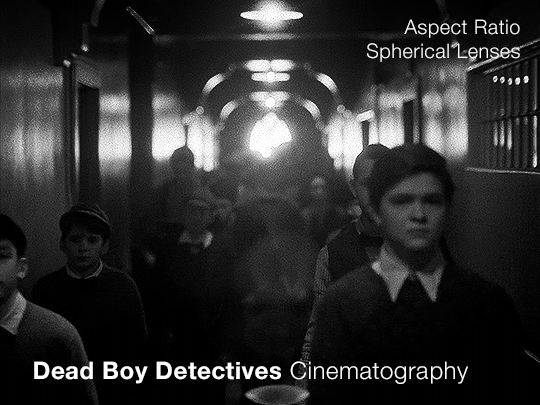
Part 2 — this time with a focus on the flashbacks
(Check out the first post for some background info that will be useful)
When we’re looking at the cinematography of any piece, once we’ve established what the norm is (which is the use of anamorphic lenses, as per the last post) we can then look to see where it diverges. As far as I can tell, the only part of Dead Boy Detectives that doesn’t use an anamorphic lens is Edwin’s flashback scene.
Now this is particularly interesting since not only is it filmed with a spherical lens, but it also is the only scene with a different aspect ratio, and the only scene in black and white. Everything about this scene is glaringly different. The easy and obvious reason is that it sets this scene apart as something important to pay attention to, as well as emphasizing the difference in the time period. But I want to highlight how exactly it does this since it is quite clever.
It also raises the question: Why not film Charles’ flashback scenes differently?
Like last time, let’s start with a review of history and technical information.
What is an aspect ratio?
This is just the ratio of the width to height of the frame. 1:1 is a square, whereas 2:1 is a rectangle twice as wide as it is high. In film, aspect ratios are usually listed as a ratio of x:1, so you get common formats like 1.85:1 and 2.39:1 (the second being a super-widescreen format, i.e. a long rectangle). Other common ratios are listed with different numbers, like 4:3 and 16:9. Any time I write an aspect ratio with other numbers, I’ll also list it at least once with the x:1 format so you can compare things easily.
What are some common aspect ratios and what have the standards been across the past 100+ years of film and television history?
Brief history of aspect ratios in Film
The original silent films were mostly filmed in 4:3 (1.33:1). This aspect ratio persisted until the late 20s/early 30s when the Academy Ratio, 1.375:1, was introduced and somewhat standardized (at least in the USA) until the 50s. Then, widescreen became pretty popular and was used to draw audiences to the theaters. At this point, we get tons of variation in aspect ratios in films. But, for American theaters, common projections are 1.85:1 (which became super common) and 2.40:1 or 2.39:1, whereas in some European theaters, 1.66:1 is a more common ratio.
Some other common ratios deal particularly with 70mm film:
Standard 70mm film is usually 2.2:1. However, using anamorphic lenses will create a higher aspect ratio, and unless using a specific format common in the 50s and 60s (Todd-AO), this wasn’t often the aspect ratio that viewers would see. (The Sound of Music was shot with Todd-AO in 2.2:1, but until recently, most people only saw the general release in 35mm, which had a different aspect ratio)
IMAX, which is 1.43:1 (if IMAX is shot on film and not digital, it uses 70mm film)
Brief history of aspect ratios in Television
Pretty much all televisions until around the 1990s-2000s used 4:3, and broadcasters would show content in that aspect ratio. If a movie was broadcast over TV, sometimes there would be letterboxing (black bars), but pan-and-scan was common, where they would crop the movie to the 4:3 ratio, and pan around to wherever the action was happening. Starting in the 90s, widescreen televisions started to gain traction, and the 16:9 (1.77:1) format prevailed, and TV broadcasting had some more wiggle room for aspect ratio.
**Side note: Computers are often at this ratio, so if you watch older TV shows on your laptop, you’ll probably see pillarboxing (black columns on the sides), whereas newer movies are often shot with higher aspect ratios so they have letterboxing (black bars on the top and bottom)**
A note on widescreen
Movies are usually considered widescreen if they’re any higher than 4:3 (or 1.33:1). However, because of the aspect ratio of modern TVs and computers, and the even higher aspect ratios of most smartphones in landscape mode, a lot of people (especially younger generations) won’t consider things “widescreen” until they’ve got a much higher aspect ratio.
Streaming and Aspect Ratios
A weird effect of streaming services, and in particular Netflix, was the rise of a new standard in aspect ratios, 2:1. It’s used in shows like Stranger Things. It’s widescreen enough that it feels cinematic but it displays well on lots of devices. There’s minimal letterboxing (or none) on your phone, and more letterboxing on your computer and TV, but not enough to seem like you’re watching a movie instead of a show.
Netflix (and Amazon) really like this aspect ratio. In 2017, one of the production requirement documents from Netflix stated that any aspect ratio greater than 2:1 had to be subject to further approval (though now they state “Aspect ratio choices should be discussed with Netflix for approval”). It’s become increasingly common, and these companies have a pretty set standard for 1.9:1 and 2:1. If we see those ratios on a streaming show it isn’t always a creative choice, similar to the way older TV shows were required to be in 4:3.
A brief reminder about lens types with some extra bits about the timeline.
That 2.39:1 aspect ratio that movies use? That’s the standard for anamorphic lenses (discussed in Part 1). Anamorphic technology was developed around 1915 (for military reasons), but wasn’t used for films until 1927, and didn’t become commonly used until the 50s.
So, with that, let’s look at Dead Boy Detectives.
Aspect Ratio
The whole show is shot with anamorphic lenses, but instead of a 2.39:1 ratio, they use a 2.2:1 ratio. This is a really interesting choice since it is an uncommon ratio. It’s more widescreen than Netflix shows (they started shooting before being acquired by Netflix though so we can ignore any impact Netflix may have had on this decision) but not quite the widescreen that anamorphic lenses typically use.
Movies and shows can use almost any aspect ratio today, but it is still common to stick to the standards. When they choose something else, it’s not because of technical limitations, but because of a creative choice.
The one caveat I have is that Doom Patrol used 2.2:1, so it’s possible that HBO and DC originally just chose this for continuity between the two, before the show was shifted over to Netflix and the Sandman universe. But for this post, I’m going to assume that they were sort of starting from scratch when choosing the look.
If we consider what a 2.2:1 ratio has been used for, and what viewers have been “trained” to associate it with, we end up with Todd-AO 70mm prints and a few others from the 50s and 60s. It’s the kind of aspect ratio you don’t see often unless you’re lucky enough to live near a theater with a 70mm film projector. There are a few notable movies shot in this aspect ratio: Lawrence of Arabia and 2001: A Space Odyssey. Some more recent movies that used 2.2:1 include Dunkirk, Tomorrowland, Nope, and the non-IMAX parts of Oppenheimer. It’s also occasionally used in recent TV, but not a ton, and not with many popular shows.
This is an aspect ratio used by large-format, high-budget movies. As mentioned in the previous post, anamorphic lenses are associated with a romanticized notion of “cinema” and this aspect ratio only serves to further that, associating Dead Boy Detectives with the limited pool of content made in this aspect ratio. It may be a TV show, but it’s being shot like a movie.
Another really interesting point that follows up on the previous post is the idea of using cinematography to enhance the sense of the supernatural and separate the characters from the normalcy of the real world. The aspect ratio is a bit unnatural too, which serves to complement and augment this.
Let’s briefly look at what the show would look like in different aspect ratios. As a baseline, this is the 2.2:1 aspect ratio that the show is in:
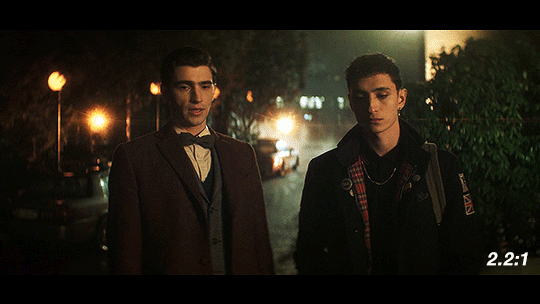
If they had gone for a 2.39:1, a very typical aspect ratio for the kind of lenses they’re using, it would look like this:
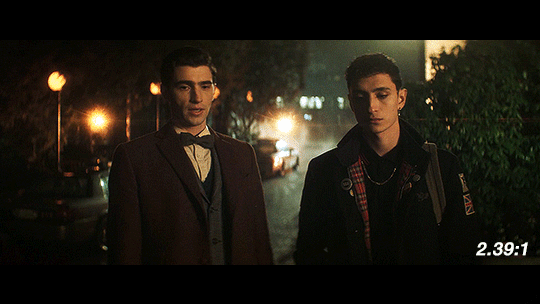
When we see things shot with anamorphic lenses, we’re used to seeing it in a frame like this one. Especially in shots like this with the dramatic lens flares, this is going to look and feel familiar to people who watch a lot of movies. It has more of that Star Trek (2009) look, and feels kind of glossy and polished.
Next up, we have 2:1, the aspect ratio popularized by Netflix. It’s a reasonable possibility that if this show had been produced by Netflix from the very beginning, this is what it would look like.
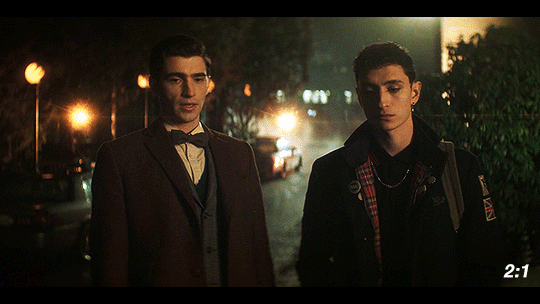
Over the past few years, this has become the “streaming platform” aspect ratio. With the extra vertical height, it’s got some extra space to breathe. We would get less of the background and more of the characters, especially since Dead Boy Detectives favors centered shots of single characters over group shots like this one.
Finally, I’ve got the scene in 1.85:1, a ubiquitous film aspect ratio, yet one that is not used often on TV.
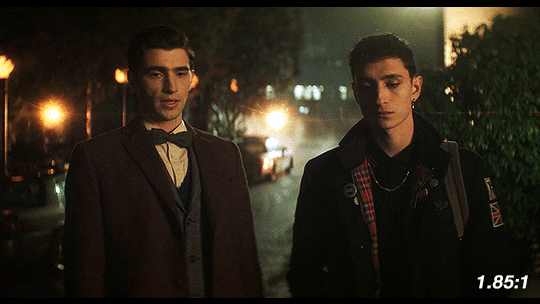
This is considered to be standard widescreen and it’s a great aspect ratio. Given how many creative decisions in this show were made to emphasize the supernatural, this could have been another good option as an aspect ratio, since we’re not used to seeing TV shows like this. However, they’re using anamorphic lenses so this would have required a lot of cropping. Because of how the anamorphic lenses work, this would also necessitate a lot of additional attention during the shoot. If they had gone with 1.85:1, we likely would have gotten a show shot on sphericals instead.
So what about Edwin’s flashback?
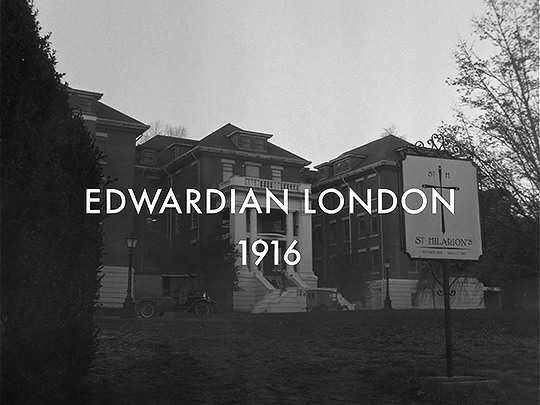
This section is shot in 4:3 (1.33:1). It’s the only part shot in a different aspect ratio. Sure, changing the aspect ratio forces us to acknowledge the difference in time period, but why exactly does it work so well?
Remember the history part? 4:3 was used for most of the early silent films. If we are to consider the “historical accuracy” of shooting the different time periods in this show, anamorphic lenses and 2.2:1 make sense for the present-day parts and Charles’ flashback.
But in 1916, widescreen cinema wasn’t a thing. If Edwin had ever been to see a movie while alive, it would have been in 4:3. The first time he would have ever gotten to see something in widescreen (if we assume he watches any movies at all) would be after he escaped Hell.
Using this aspect ratio is not just a vague decision that a lower aspect ratio and black & white looks older. It is, like many other aspects of the show, historically informed. They could have used the academy ratio here, but they didn’t. They used 4:3.
Not only does the aspect ratio switch for this scene, but also the height of the image changes.
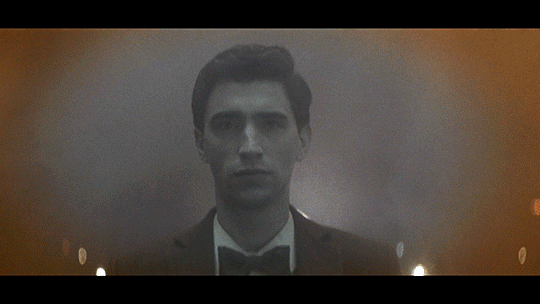
This transition also sort of mimics the breathing effect of anamorphic lenses:

Something you may not know about how Netflix usually works is that regardless of the aspect ratio of the picture, the video file you see is part of a larger container, which is usually 16:9 (1.77:1). The black bars on top and bottom are part of the file, as shown in this screenshot of how it looks when you load up some screencaps in photoshop.
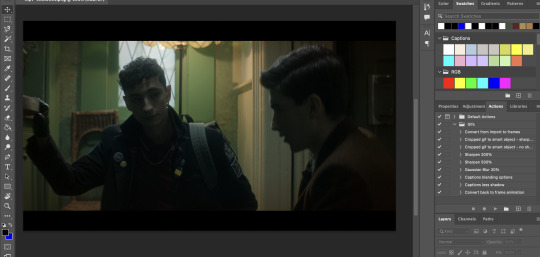
If you make gifs, edits, or are otherwise just used to having video files you are probably familiar with this. The Dead Boy Detectives files have letterboxing that is cropped out whenever people make fan content with it, whereas if you have a file for an independent movie, it usually does not have those black bars. Those black bars being part of the file make this transition possible.
We don’t usually realize that the container extends beyond the picture. For all we know, that’s the edge of the frame. But then it changes and forces us to reconsider what we previously thought to be true. Breaking out of what we think to be the image height is jarring, especially considering that this is the only time it happens (other than the brief flashbacks to the same footage later in the show).
Here’s a mockup of what it would look like if they kept the same image height, and just moved from 2.2:1 to 4:3 without expanding vertically. I find that it doesn’t have quite the same effect.
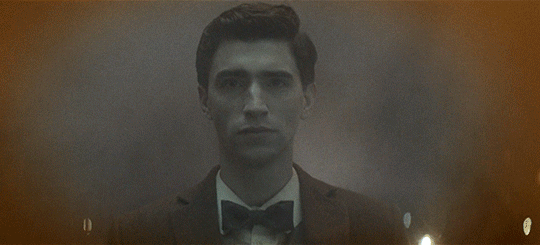
This would look so cool if it was being shown at a movie theater on a huge widescreen, but we’re not watching this show in theaters. We’re watching it on screens where this would make it look small; what they do instead retains the feel of watching something big and cinematic.
So back to the actual transition:

In breaking out of the perceived container, it’s as if it were breaking the fourth wall, an acknowledgment of the video’s format and its true container. This story is addressed to the audience in a way that the rest of the show is not, and it uses the aspect ratio to let us know that.
Spherical Lens
(I would highly recommend you read pt 1 if you haven’t already)
Edwin’s flashback is not only the sole scene with its own aspect ratio, it’s also the only scene shot with a spherical lens. Like the aspect ratio, this is a historically informed choice. Anamorphic lenses technically existed during the last year or two of Edwin’s life, but movies were not being shot on them.
How do we know that a spherical lens is being used, and how does this affect the show?
One of the quickest ways to identify the lens is to look at the shapes of the bokeh. There’s not much bokeh in the flashback, so I apologize for the intensity of my first example. But here, look behind Edwin’s head, where the lights from above reflect on the wet basement floor. They’re all circles, instead of the ovals that we get with the anamorphics.
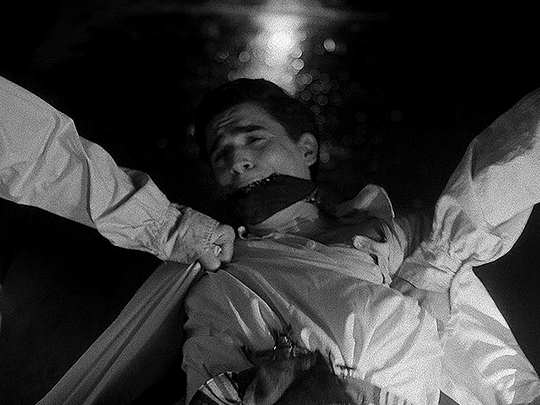
The lens flares are also really different. Remember that the anamorphic lens flares are horizontal lines. Spherical lenses don’t do that, but they can produce lots of different kinds of lens flares. In this shot, the flashlight pointed at the lens lets off lines in lots of directions, kind of like sun rays.
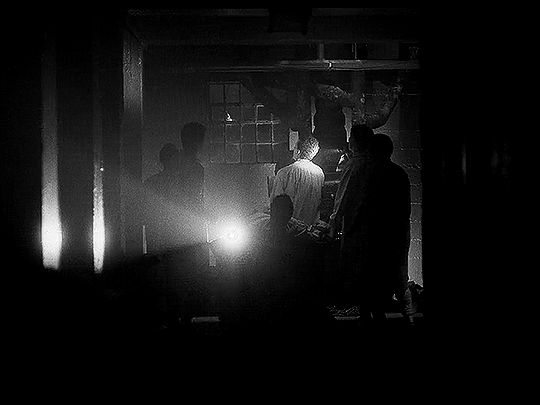
This shot has another cool flare, in much more detail this time:
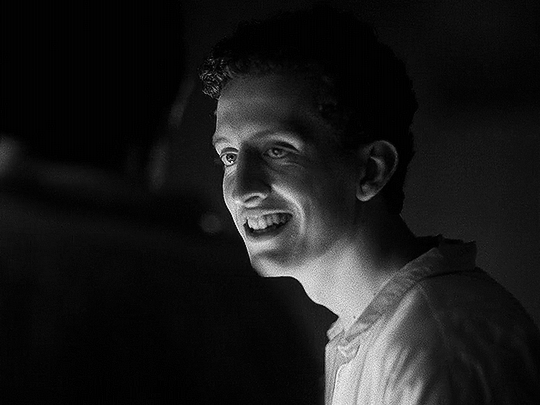
The next shot shows us more of the circular bokeh and another kind of lens flare.
For the bokeh, look at the lights on the ceiling as well as the corners of the out-of-focus architectural details (the semi-arches).
The lens flare here is the bouncing, blurry circle near the middle, as well as the brighter shape near the center bottom.
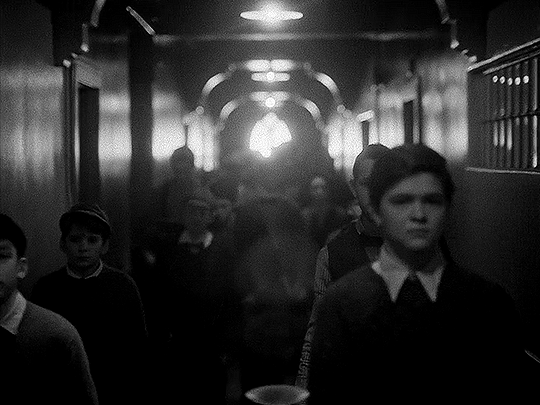
We can then look at the things that are not different, but absent when using the spherical lens: barrel distortion and focus falloff.
In this example, look at the windows in the background, as well as Edwin’s chair. An anamorphic lens would distort the vertical lines, bending them into a gentle fisheye. It would also make that chair and the lines of the window frames a bit blurry, as they’re close to the edges of the frame. Instead, the lines are straight and clear throughout the whole shot.
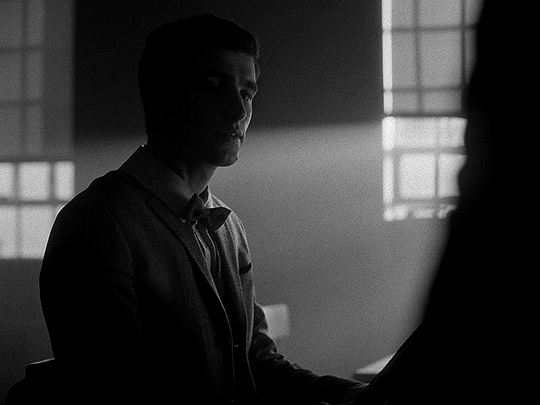
In this next example, not only do we get a great view of the lack of focus falloff, with clear lines throughout the shot, but we can see more of the difference in perspective and distortion of lines.
You may notice that the windows and doors are not perfectly straight up and down. But is this barrel distortion? If there was barrel distortion, the walls would curve back towards the center of the frame at the top.
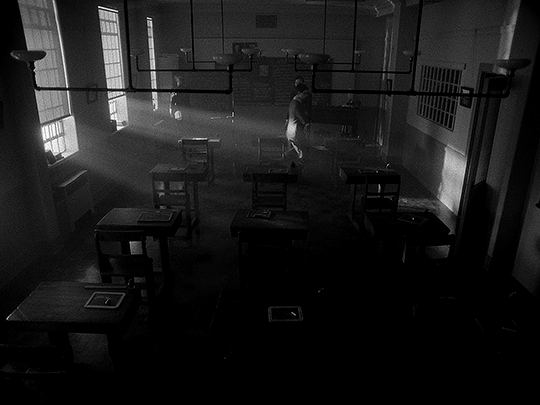
Spherical lenses are often the ‘default’ lens. They’re wonderful and used in a lot of media because they are neutral. They distort less, thus representing the world closer to how it actually is. If we consider the anamorphic lenses in the rest of the show being used to enhance the sense of supernatural and story, changing to a spherical lens enhances the sharp reality. This is Edwin, alive.
The image breaks out of its perceived container, reaching out to the audience, and then changes the lens to be more ‘real.’ In these two changes, not only do we have a more historically accurate image, but it's as if the creators are issuing a warning to us. Maybe the demon isn’t real, but bullies are. Kids can be cruel. Classmates hurt their queer peers. This is not fantasy, and this is as true in 1916 as it is today.
Using a spherical lens in this instance, juxtaposed to the rest of the show, is a dramatic shift to make, as it alters just about everything in the image. In using a less distorted picture, for this, we are reminded of reality and life and the mundane.
On Charles’ Flashback (and an experiment)
Edwin’s flashback got the Cinematography Treatment™ but what about Charles’ flashback? It’s shot with the same aspect ratio and lens as the rest of the show. From the perspective of historical accuracy, this is fine. It’s a scene that could have been shot in 1989, cinematographically speaking. The reason I suspect that it wasn’t given any stand-out look is because, unlike Edwin’s flashback, Charles’ flashback scenes are closely tied to the present-day plot. They aren’t just scenes of Charles remembering things, they are a direct result of the Night Nurse’s “memory magic.”
Maybe changing something here would separate us too much from the plot. Both flashbacks (in episodes 4 and 7) are induced for a specific purpose related to other present-day characters. It wouldn’t make as much sense to have them be standalones.
However, if I were simultaneously the showrunner, screenwriter, and cinematographer, I would give Charles a standalone flashback scene. In that flashback scene, here’s how I would shoot it:
There would be a much deeper depth of field/smaller aperture than the rest of the show, so the background would be more in focus.
There would be harder, less-diffused lighting. This would also impact the coloring, and I’d maybe add some more saturated lights.
I’d try to make an argument to shoot that scene on film (and then argue to do Edwin’s on film too).
There would be a different aspect ratio; 2.2:1 isn’t out of the realm of possibility for the 80s, but it wasn’t common, and it wouldn’t have the kind of impact I’m searching for if it didn’t change.
There are three different aspect ratios I would choose between, and the lens would change depending on my pick.
I’ve made some mock-ups for how these would look, though I cannot adjust things like bokeh and depth of focus, and I can only do so much with the lighting.
2.39:1 with anamorphic lenses (specifically Panavision lenses) This is a super standard widescreen, with a popular lens from the time. We don’t have lens info for the rest of the show, but I think they’re using Panavision anamorphics anyway so the lens may not be a change. Big, blockbuster action movies from the 80s would often be shot in this (perhaps most relevantly, Ghostbusters), and it’s a style that kind of faded in popularity in the 90s and 2000s, so it can have more of a retro look, especially if shot on film. One downside to this would be the aspect ratio change would not be as dramatic.
Movies from the 80s shot with this combo: Raiders of the Lost Ark (and other Indiana Jones movies), Star Wars: Episode V - The Empire Strikes Back (as well as Episode 4, which came out in the 70s. Episode 6 used the same ratio and did use anamorphic lenses, but not Panavision), Ghostbusters
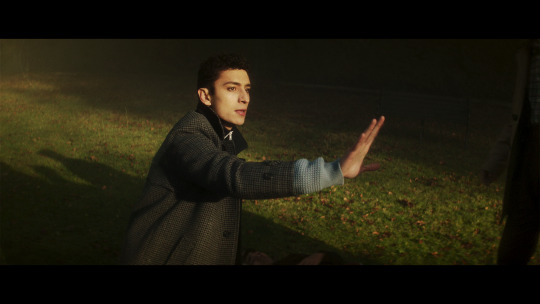
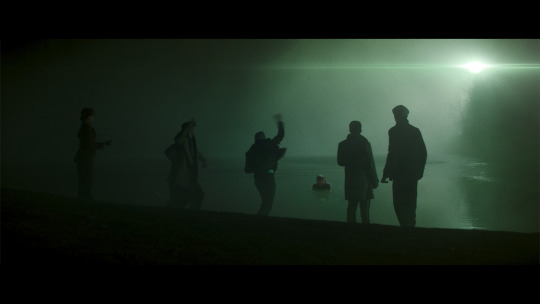
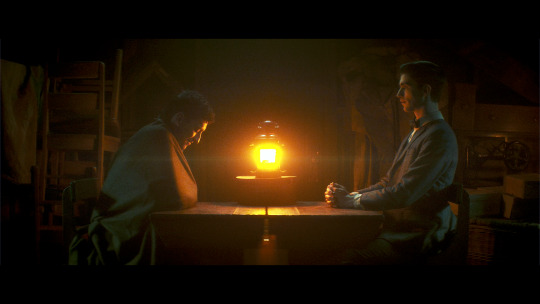
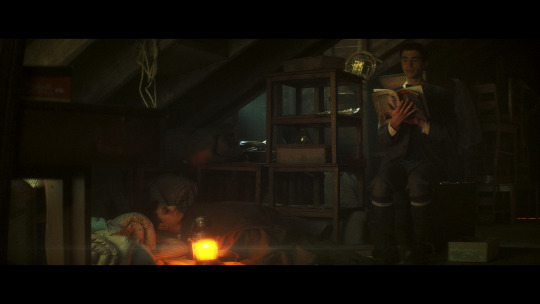
1.85:1 and spherical lenses. This is also ‘widescreen,’ but the advantage of using this aspect ratio is that we could get another dramatic breaking of the image container, just like in Edwin’s flashback. It’s an incredibly common setup, so it’s not really unique, but it would look different from the rest of the show. Given how pervasive ultra-widescreen still is today, I think a lower aspect ratio would also ramp up the ‘nostalgia’ factor a bit. Using a spherical lens we’d end up with the same sense of stark reality that we get for Edwin’s flashback as well (the warning that kids are cruel, but this time to people of color), and I like the idea of that as a parallel.
Movies from the 80s shot with this combo: Back to the Future, Dirty Dancing, The Princess Bride, An American Werewolf in London, Clue, Another Country
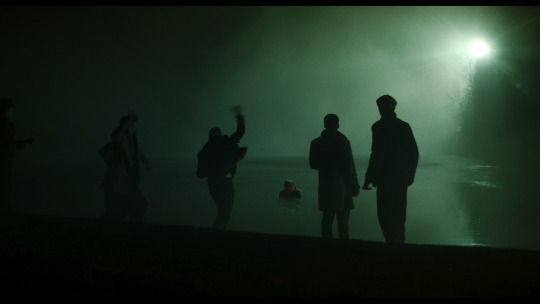
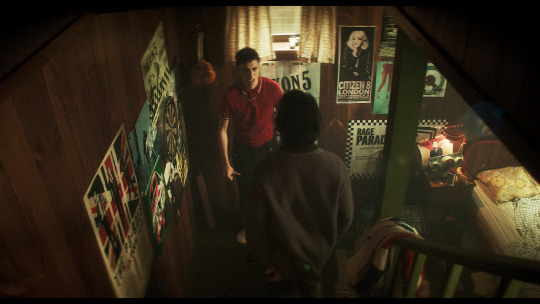


1.66:1 and spherical lenses. This is a ratio that was used widely across Europe, but has never been a common ratio in the USA. However, by the 80s, filmmakers were going for a more widescreen look so it was fading from popularity everywhere. The 80s liked widescreen, so it’s maybe not the best pick for making a scene look “80s”. However, my main motivation for this ratio is that my personal picks for the most Edwin-coded and most Charles-coded queer films are both 80s films shot with a 1.66:1 ratio. We would also get the same benefits from using the spherical lens as I mentioned in the 1.85:1 section.
Movies from the 80s shot with this combo: Maurice, My Beautiful Laundrette, Law of Desire (La ley del deseo), and an honorable mention to Chungking Express, a 90s film that really exemplifies the kind of look I'm going for here
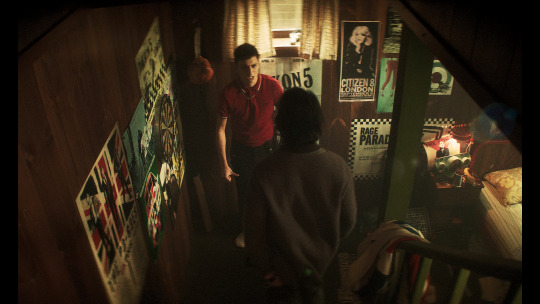
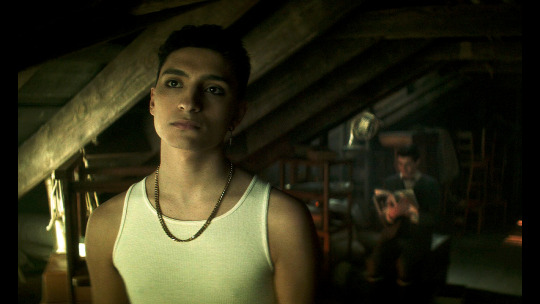
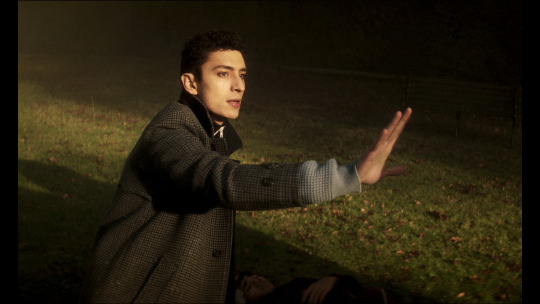
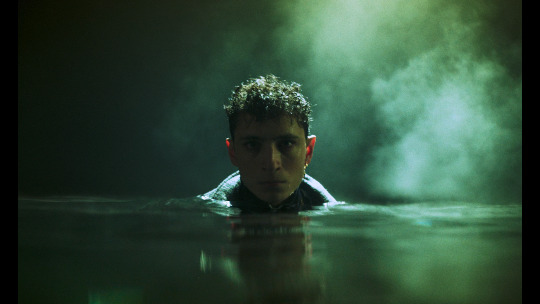
Giving Charles’ flashback a special treatment would probably do a lot to more firmly establish his character as a co-protagonist rather than a deuteragonist, which is definitely not the case but does seem to be how some people view him.
With the impact of the spherical lens and aspect ratio in Edwin’s flashback, the final two options for Charles flashback would be the closest in terms of echoing Edwin’s flashback, and would probably provide the most gravity and sense of crushing reality to the scene.
Setting a single scene (or two scenes) aside like this, with a unique aspect ratio, lens, and color grading (which I didn’t explore much for the Charles flashback), makes us consider a scene more independently from the rest of the show. Edwin’s flashback is a striking moment with a very different look, and that’s deeply memorable. It comes together to push how tragic and unjust Edwin’s story is.
—————
This concludes the planned portion of my cinematography analysis. I had a ton of fun researching and writing this (and making all the graphics) and I hope you all find this interesting/helpful/informative :)
Finally, I want to give another name drop to the cinematographers, Marc Laliberté, Craig Powell, and Pierre Gill. They’ve really nailed it from the very first episode to the last, and there’s so much intention and thought given to every aspect of how they shoot this.
#dead boy detectives#dbda meta#dbda#edwin payne#charles rowland#cinematography#dead boy detectives analysis#cinematography analysis#mygifs#dbdagifs
283 notes
·
View notes
Text
Paul's reaction to being played on GDR radio
This quote is from the book "Wir wollen immer artig sein...Punk, New-Wave, Hip-hop und Independent-szene in der DDR von 1980-1990", pages 559 and 565.
The quote is from a chapter that has an interview with Lutz Schramm, presenter of the show 'Parocktikum' that was broadcast by the official GDR radio station, initially as part of the youth-program 'DT 64'. For more information on Parocktikum see wiki (de) and the website of Lutz Schramm at parocktikum.de which also contains a wiki to people and places from the era.
Interesting tidbit on the page for Flake which a.o. mentions the many collabs that Flake did like "Flake & Piet (mit ... Piet? Mancherorts wird behauptet, auch "Piet" wäre Paul Landers)" translated "Flake & Piet (with ... Piet? In some places it is claimed that "Piet" is also Paul Landers)". And announced recently was that on 7 feb 2025 Flake and Piet's release will be re-released 🌺 but back to the quote.. 😊
Lutz Schramm is asked which music he played (what he liked himself), if he was hindered a lot by officials (not very much, although he took care not to play too political songs like 'Anti-Armia' by 'Die Frirma'), how people and fans sent him cassettetapes to play (because there wasn't much else for bands to distribute their music), and what the artists in the 'scene' thought about being played on state radio.
Hat es denn Fälle von Distanzierungen von seiten der Szene zu deiner Sendung 'Parocktikum' gegeben?
Schramm: "Ja, zum Beispiel hat mich Paul Landers von Feeling B angerufen und mir mitgeteilt: 'Die Magdalene Keibel Combo hat in deiner Sendung nichts zu suchen, spiel die nicht!'. Ich hab dann am Telefon ein bißchen mit ihm rumdiskuttiert, er meinte: 'Die Leute kommen bei Konzerten zu uns und erzählen, ihr lauft da im Ost-Radio, das ist nicht so toll!' Ich erklärte ihm, ich spiel das, weil mir die Musik gefällt und nicht wegen irgendwelchen politischen Geschichten, aber er erwiderte, letztendlich geht es haptsächlich um die politischen Geschichten. Ich sagte ihm dann: 'Okay, wahrscheinlich hast du recht, dan lassen wir es eben'. Ich hab's dann einmal gespielt und sonst kein Verbot dafür bekommen. Solche Geschichten sind eben vor allem gelaufen, da gab es auch noch einige andere. Verhältnismäßig oft ist es passiert, daß Musiker gesagt oder geschrieben haben: 'Spiel uns nicht, weil das möglicherweise unsere Street-Credibility beschädigt'."
Um sich selbst vor staatlichem Zugriff zu schützen oder um ihre Fans nicht zu enttäuschen?
Schramm:"Eher das."
translated
Have there been any cases of distancing from the scene towards your show 'Parocktikum'?
Schramm: "Yes, for example, Paul Landers from Feeling B called me and told me: 'The Magdalene Keibel Combo has no place in your show, don't play it!'. I then argued a bit with him on the phone, he said : 'People come to us at concerts and say you're on East radio, that's not that great!' I explained to him that I was playing it because I liked the music and not because of any politics, but he replied that in the end it is mainly about politics. I then told him: 'Okay, you're probably right, so we'll leave it at this '. I played it once and didn't get bother for it. Stories like that happened, and there were quite a few others. What happened relatively a lot was musicians said or wrote: 'Don't play us, because of that possibly damages our Street credibility'."
To protect themselves from government access or not to disappoint your fans?
Schramm: "More the latter."

Lutz is also asked if all GDR bands were originals or just copies of english or american bands
Schramm:"Feeling B ist, glaube ich, das Authentischte, was du finden kannst, weil die auch nicht Musik im eigentlichen Sinne gemacht haben, die haben eben irgendwie nur irgendwas gemacht, das war so: plopp!
translated
Schramm: "Feeling B is, I think, the most authentic thing you can find, because they didn't make music in the actual sense, they just somehow did something, it was like: plop!
🌺
more quotes by or about Rammstein or related topics
19 notes
·
View notes
Text
How Other Researchers Can Help

I got a question about this a few days back, and I've been thinking about it a bit more. The more people researching Chelouranya, Aristasian, Romantia, and Lux Madriana the merrier. And there are certainly some things that exist out there in Tellurian that I just can't get my hands on, due to the fact I don't live on the same continent. I would definitely suggest making a Tumblr side blog and just adding the appropriate tags and tossing whatever you find out into the ether. If you tag it with Aristasia, I'll certainly see it.
The following list will hopefully be helpful in finding those lost bits of history, both for digital researchers, as well as researchers in the real word (the physical, right-now, tellurian real world, not the other type), I will perhaps be updating it new things to find are discovered to be findable:
❧ Finding archives of lost websites, or even fragments of websites and forum discussions that are still online.
❧ Even just digging through the archives of known Aristasian websites for interesting bits of discussion is useful! If you don't know where to start, the archived Aristasian Preservation Project page is a good place.
❧ If you're in the UK, there's still hope that some old Madrian literature is out there, gathering dust in used book stores. Even if you're not in the UK, we know for a fact we know for a fact that many of their publications were sent all over the world!
❧ If you're near Glasgow, there is the Glasgow Woman's Library that has the full Artemis run. They're currently unable to digitize it, but allow researchers to view their archive in person, and are fine with you making copies of snapping photos of pages (at least they were the last time I messaged them!). You could be the heroine that puts these volumes online for the first time ever!
❧ If you're in the US, and have access to a college library, there are a handful of colleges that have Artemis listed in their LGBT+ archives. These may be the already archived copies (vol 5 and 6), or they may not be, it's hard to tell from just the online listings.
❧ The more eyes looking for related books, magazines, and even news broadcasts the better. The following media have been mentioned before, in some relation to Aristasia, but no known copies are archived online, or readily available to be purchased. These may have useful information, or it may just be a rehash of what we know already. We simply have to find them first to discover that: ➳➳ Joanne Carminhow, The Light of the Goddess: Lux Madriana
➳➳ Original Rhennish language copy of The Crystal Tablet
➳➳ March 1982's Behind The Veil broadcast
➳➳ 1988's Issue 9 of Odin magazine with an article by Wolfheim Coll, who was the lone male of the original 4 Madrian founders.
➳➳ The Chap magazines from September 2004 through Bridgehead in late 2005, where Miss Martindale apparently had an advice column.
➳➳ Any of the Miss Martindale TV appearances from the mid-to-late 1990s.
➳➳ Any of the number of cassette tapes they sold in the late 1980s and 1990s. These had a number of different names, such as "Imperial Home Service" "Audio Dreams" and "A Feminine Journey". I would be willing to take a chance bet that any of these tapes would have one of their BM Elegance/Labrys/Perfect London forwarding addresses printed on the label, so it would be easy to spot, even if it had a different name.
❧ There are also some much more vague periodicals out there that may, possibly, mention the girls from Aristasia because they previously were mentioned in similar magazines, so it's worh poking around if you happen to stumble across any of the following:
➳➳ British computer game magazines from about 1984-1987 that may feature interviews with any of the St. Bride's girls.
➳➳ Pagan or Goddess magazines published in Oxford from 1975-1977ish that may mention the beginnings of Lux Madriana
➳➳ Hebden Bridge newspapers from 1981-1982 when there were several Madrian households in Hebden Bridge and they frequently appeared in local newspapers.
➳➳ Late 1970s to early 1980s new age, feminist, and pagan resource listings. Many of the different projects that Lux Madriana can be found in these.
➳➳ Late 1980s to late 1990s fetish and alternative lifestyle resource listings. This appeared to be the start of their active, not just accidental, involvement in the fetish scene. It's rumored that they advertised their services in the late 90s in adult magazines, and we can find evidence of them advertising such things during the Wildfire Club era.
If you're doing digital searches, there's a seemingly infinite list of search terms that will bring up results that may be related, and these include the unusual nom de plums used by the Madrians, the known phone numbers and addresses they used in their advertisements and published correspondence, as well as unusual terms that they frequently used. At some point I will make a list of some of the terms I search for.
10 notes
·
View notes
Text
The Zelensky Story (BBC)

Synpopsis
This definitive boxset series tells the extraordinary story of Volodymyr Zelensky, a comedian who played the president, then became the real President of Ukraine… Told across three episodes, the series charts Zelensky’s journey from young actor and entertainer to one of the most recognisable leaders on the planet, presiding over a nation at war with Vladimir Putin’s Russia.
Filmed over several trips to Ukraine, Series Director Michael Waldman is granted rare access to interview President Zelensky and First Lady Olena Zelenska, who speak in unguarded terms about their extraordinary lives. What emerges is a portrait of a young couple plunged into an extraordinary situation – childhood sweethearts who got married and rose to stardom, before being thrown into politics, and into the heart of the biggest invasion in Europe since World War II.
As well as interviews with the family and their inner circle, the series includes new accounts from world leaders including Boris Johnson, Nancy Pelosi, former UK Defence Secretary Ben Wallace, and Advisor to the President of Ukraine Mykhailo Podolyak, who each give dramatic first-hand testimony of their dealings with Zelensky – and Putin - in the lead up to a full-scale military invasion.
Combining exclusive interviews with extraordinary archive footage never before broadcast in the UK, the series sheds new light on the origins of the war in Ukraine and the two men at its epicentre: Vladimir Putin and Volodymyr Zelensky.
With unique access to Volodymyr Zelensky and Olena Zelenska, this episode charts Zelensky’s extraordinary journey from aspiring comedian to president of his country.
Opening with the collapse of the Soviet Union – an event which had a profound effect on Volodymyr Zelensky and Vladimir Putin in very different ways - it features rarely seen footage of Putin in the early 1990s describing the collapse of the USSR as a “tragedy”.
Alongside archive footage of a young Zelensky performing, his wife, childhood friends and former colleagues describe how Zelensky became a famous comedian both in Ukraine and in Russia, at one point cracking an early gag about Putin. He goes on to win Ukraine’s Dancing with the Stars, and becomes the voice of Paddington Bear.
In 2014 the Maidan Revolution sparks an initial political awakening in Zelensky. When he is asked to go on live TV, he chooses to speak out against the corrupt Ukrainian president and, extraordinarily, addresses Putin directly.
Zelensky goes on to produce and star in a hit TV show about an ordinary Ukrainian who becomes president of his country, called Servant of the People. It proves to be a remarkable foreshadowing.
As Zelensky’s star continues to rise, First Lady Olena Zelenska makes a jaw-dropping revelation - he didn’t tell her that he had decided to run for president in real life. She recalls how she discovered the news along with the rest of the nation, while watching TV. President Zelensky responds by looking directly down the lens and apologising to his wife. As the episode comes to a close, Mrs Zelenska reveals, for the first time, that she had a faint hope her husband would not win the election.
Episode 1 (The Comedian and The Dictator)
With unique access to Volodymyr Zelensky and Olena Zelenska, this episode charts Zelensky’s extraordinary journey from aspiring comedian to president of his country.
Opening with the collapse of the Soviet Union – an event which had a profound effect on Zelensky and Vladimir Putin in very different ways – to the Maidan Revolution sparking a political awakening in Zelensky, this episode explores his role as the Ukrainian president in the hit TV show Servant of the People and his decision to run for president in real life.
(September 4)
Episode 2
After the high of his election victory, Zelensky is forced to face political reality. Using in-depth interviews with Zelensky, his wife Olena Zelenska, and their closest advisors, the film puts the viewer inside the room as Zelensky grapples with what it means to be the leader of a country.
From Zelensky’s infamous phone call with Donald Trump to his only meeting with Vladimir Putin in Paris, the former comedian has a brutal initiation into the ruthless world of power politics. As Putin becomes increasingly belligerent and the drumbeat of war grows louder, Zelensky is under a huge amount of pressure. Is Ukraine prepared for war? Is Zelensky up to the job?
Episode 3
Opening in the first hours of the Russian invasion, this final episode follows explores how Zelensky used the skills he’d honed as an entertainer to galvanise people, as well as taking viewers inside Ukraine’s peace negotiations with Russia. And the Zelenskys reveal what happened in the first hours of the Russian invasion, open up about the realities of living through war and the difficulty of making life and death decisions.
13 notes
·
View notes
Text
youtube
The Complete Amateur's Guide to Moomin
By popular demand, I have compiled every video in my 'Amateur's Guide to Moomin' into one convenient video, with additional footnotes, corrections, and a newly added section discussing the changes that have occurred with the Moomin series since the publishing of the original videos. Join me as I explore the series' history and its author, Tove Jansson, to discover what we can learn from this peaceful family of trolls.
Special thanks to @marsmombestmom for helping with the Swedish Translation and corrections.
Bibliography:
Augsburger Puppenkiste. Die Muminfamilie, ARD, 1959.
Boel Westin. Tove Jansson : Life, Art, Words : The Authorised Biography. London, Sort Of, 2014.
Bosworth, Mark. “Tove Jansson: Love, War and the Moomins.” BBC News, BBC, 13 Mar. 2014, bbc.com/news/magazine-26529309.
Box, Steve, et al. Moominvalley. Yle TV2 / Sky One, 25 Feb. 2019. 13 x 22 minutes.
Dębiński, Lucjan, and Maria Kossakowska. The Moomins, Episode 1-100, Se-Ma-For, 1977.
Gutsy Animation. “Moominvalley Crowdfunding Campaign.” Indiegogo, 8 Mar. 2017, indiegogo.com/projects/moomin#. Accessed 30 May 2023.
Jansson, Tove, and Elizabeth Portch. Comet in Moominland. Puffin Books, 2019.
Jansson, Tove, and Kingsley Hart. Moominpappa at Sea. Puffin Books, 2019.
Jansson, Tove, and Kingsley Hart. Moominvalley in November. Sort Of Books, 2018.
Jansson, Tove, and Thomas Warburton. Moominsummer Madness. Puffin Books, 2019.
Jansson, Tove. Finn Family Moomintroll. Translated by Elizabeth Portch, Puffin Books, 2019.
Jansson, Tove. Moomin: The Complete Tove Jansson Comic Strip. Drawn & Quarterly, 2010.
Jansson, Tove. Moominland Midwinter. Paw Prints, 2008.
Jansson, Tove. Tales from Moominvalley. Penguin Books Ltd, 2019.
Jansson, Tove. The Exploits of Moominpappa. Penguin Books Ltd, 2019.
Jansson, Tove. The Moomins and the Great Flood. Drawn & Quarterly, 2018.
Karjalainen, Tuula, and David McDuff. Tove Jansson: Work and Love. Penguin Books, 2016.
Lamppu, Eva. “Big in Japan, but Could America Love Moomin?” Reuters, Thomson Reuters, 6 Oct. 2009, reuters.com/article/us-moomins/big-in-japan-but-could-america-love-moomin-idUSTRE59501Z20091006.
Miyazaki, Akira, et al. “Tanoshii Mūmin Ikka.” Tanoshii Mūmin Ikka, season 1, episode 1-78, TV Tokyo, 1990.
“Moomin Characters as Tove's Self-Portraits.” Moomin, 15 May 2019, moomin.com/en/blog/moomin-characters-as-toves-self-portraits.
“Moomin Products in the 1950s.” Moomin, 15 May 2019, moomin.com/en/blog/moomins-in-the-1950s.
Moomintrivia. “Psychology of The Invisible Child.” Moomin Trivia, 10 June 2019, moomintrivia.tumblr.com/post/185491696931/psychology-of-the-invisible-child.
Moyle, Franny. Moominland Tales: The Life of Tove Jansson. Youtube, BBC 4, 2012, youtube.com/watch?v=tYgC0nKyF0g.
“The Story of How Moomintroll Was Born.” Moomin, 12 Jan. 2020, moomin.com/en/blog/the-story-of-how-moomintroll-was-born.
“Who Inspired Tove When Creating Moominmamma?” Moomin, 15 May 2019, moomin.com/en/blog/who-inspired-tove-when-creating-moominmamma.
“Who Inspired Tove When Creating Moominpappa?” Moomin, 15 May 2019, moomin.com/en/blog/who-inspired-tove-when-creating-moominpappa.
Yamazaki, Tadaaki. Moomin, Fuji TV, 1969.
YLE News. “Finland’s Most Expensive TV Show: New Moominvalley Series.” Yleisradio Oy, the Finnish Broadcasting Company, 25 Jan. 2019, yle.fi/a/3-10614150. Accessed 30 May 2023.
#video essay#moominhouse#moominvalley#the moomins#tanoshii moomin ikka#moomin#snufmin#moomin x snufkin#snufmumriken#little my#moomin video#comet in moominland#tove jansson#Youtube
140 notes
·
View notes
Text
History of Podcasts
The origin of podcasts date back to the early 2000s. But the very beginning of its roots date all the way back to 1990s during audio blogging and radio broadcasting.
The Timeline
1990s: Early radio shows and digital audio shows on the internet
Before podcasts were available, some websites still managed to create downloadable content in the form of audio files. This was essentially the guidelines that lead to modern podcasts.
2004: The Start of Podcasting
Thanks to Ben Hammersley, we have the term "Podcast" from a 2004 Guardian Article which is a combination of both words "iPod" and "Broadcast". Yes it was made for apple initially but was adopted on a world wide scale.
2010s: The Golden Age, so to speak.
Spotify and various Apple products helped boost consumption of this media through phones and streaming platforms.
Even popular shows way back when used to use podcasts as a way of storytelling so thats nifty I suppose. I mean the show "Serial" from 2014 if I'm going off the top of my head. We still use this as a way to create stories.
2020s: The freaking pandemic itself
Listenership sky rocketed during covid, I know I did contribute too to keep myself from going insane
Amazon, Google and Spotify also invested heavily in exclusive podcasts for this reason making it a billion-dollar industry in a couple of years essentially.
Now why do we need podcasts?
Education and learning for one:
Podcasts are accessible to those with a smartphone, so it was like Duolingo but for people who just wanted to listen (valid). You can use podcasts for history, business, psychology and new skills. It extends to self-improvement. Some examples would be The History of Japan or even TED Talks Daily.
Storytelling and Entertainment
Immersive stories surrounding fictional worlds through podcasts, pretty similar to audiobooks. There are so many honestly its amazing.
Current Events in the world
They also use podcasts for detailed yet quick updates without having to read through extensive articles. You know... The Daily by The New York Times. I can't be the only one who listened to them sometimes.
Mental Health
Therapy discussions, meditation and self help is popular through podcasts which is amazing since therapy is crazy expensive no matter where.
Niche and community interests
People also manage to find podcasts that speak on their own very specific interests which range from philosophy to gaming. I am yet to find some of these that interest me so forgive me or I would have given an example.
Thanks for reading! And for more, I recommend this video by the founder of Podastery Studios Beau York. I love his explanation on the power of audio.
youtube
#podcasts#education#I should go back to my podcasts fr#but if I do that I would never be in reality ahah#covid core fr#Youtube
2 notes
·
View notes
Text
Profile | Faye Wong’s career as Cantopop singer and actress, and her very public romances (2025)
A ‘natural-born actress’, Wong Kar-wai said. The bestselling female Cantopop artist. Yet Faye Wong left it all behind to be a wife and mum
by Lisa Cam
SCMP Hong Kong's pop culture icons
This is the 44th installment in a biweekly series profiling major Hong Kong pop culture figures of recent decades. ——————————————————————
Faye Wong reigned supreme as Hong Kong’s diva of the 1990s. Her distinctive voice, artistic integrity, aversion to celebrity and unique style cemented her status..
While many will recognise her from her cover of The Cranberries’ track “Dreams” or her vocals on “Eyes on Me” (the theme song for the video game Final Fantasy VIII), her breakthrough came with her fourth studio album, Coming Home (1992). Before this, the Beijing-born Wong had modelled and placed third in a singing competition, which led to a contract with record label Cinepoly. There, she studied under Tai See-chung, who mentored Cantopop superstars such as Anita Mui Yim-fong, Aaron Kwok Fu-shing, Andy Lau Tak-wah and Leon Lai Ming. Initially, her birth name, Wang Fei, was deemed too mainland Chinese for Hong Kong audiences, so her label rebranded her Shirley Wong, or Wong Ching-man. But after her first three albums achieved only modest success, she was sent to New York for vocal training and cultural immersion. It was there that Wong truly discovered herself. “I wandered around, visited museums and sat at cafes,” she later explained. “There were so many strange, confident-looking people. They didn’t care what other people thought of them. “I felt I was originally like that too, independent and a little rebellious. But in Hong Kong I lost myself. “I was shaped by others and became like a machine, a dress hanger. I had no personality and no sense of direction.”
It was this realisation that led to her becoming the idol she is today, a performer who transitioned from Cantopop love ballads to composing alternative tunes for her own albums. The TV series Greed of Man was Hong Kong broadcaster TVB’s big-budget show of 1992 and is still lauded as one of its best dramas. Wong’s Vulnerable Woman was the song played when the heroine tragically died and it immortalised the scene in the hearts of many. The 1993 album 100,000 Whys saw Wong come into her own. Shedding her stage name Shirley, Wong went back to using her given name, Wang Fei, in Chinese and changed her English name to Faye. The album brought grunge music to the Hong Kong public’s consciousness as well as adopting other bold style experiments of the time. “Summer of Love” was a small step away from the ballads she was known for, and appealed to her younger fans. To some, Wong’s decision to make the cover of her 1994 album Random Thoughts white with the title embossed in cream came to feel as pivotal as The Beatles’ White Album. It marked Wong’s first move into alternative rock, and included her covers of two songs by the Scottish rock group Cocteau Twins. Among the songs on the album is “Pledge”, the first one she wrote with her then partner and eventual husband Dou Wei, and the first original Mandarin song to feature on her track list. Wong’s cover of The Cranberries’ “Dream” was a landmark moment in Cantopop because of the fact that she adopted lead singer Dolores O’Riordan’s vocal style of keening and yodelling thereafter. The song featured on the soundtrack to Wong Kar-wai’s acclaimed 1994 film Chungking Express, in which Wong appeared. It catapulted her into the international spotlight.
Wong’s 1995 album Di-Dar was described by music journalist Fung Lai-chee as “the best psychedelic and bestselling avant-garde work in Cantopop, with songs that are self-centred, ignoring [the] market and others’ work”. Lovers & Strangers became one of her bestselling albums, and after its release in 1999 Guinness World Records declared Wong the bestselling female Cantopop artist of all time.
The album marked the start of moves by Wong to release more songs in Mandarin, her mother tongue, and make the Hong Kong market less of a priority.
While she was busy with her music career, Wong was also making a name as an actress. Early in her career, Wong had appeared in well-known Hong Kong-made television dramas such as The Legendary Ranger and File of Justice II. However, after establishing herself as a pop diva she stepped away from television. It was not until 2001 that she was invited to Japan to star in the Japanese drama Uso Koi, becoming the first Chinese actress to play the lead role in a Japanese TV series. In film, Wong is best known for her roles in Wong Kar-wai productions including Chungking Express and 2046, both of which he directed, and the comedy Chinese Odyssey 2002, produced by the filmmaker, for which she received a best actress nomination in the 22nd Hong Kong Film Awards and was named best actress in the Hong Kong Film Critics Society Awards.
Wong Kar-wai has repeatedly praised her acting skills, calling her a “natural-born actress”. “With just a few movements in front of the camera, the entire scene comes to life,” the director said in a 2010 interview. “No one can replace Faye. It’s truly a pity that she doesn’t act any more.”
As for her personal life, Wong first hinted to the media in 1993 that she enjoyed an intimate relationship with the musician Dou Wei, saying: “I can say that we are indeed very close now.”
A love triangle developed between Dou, Wong and Jiang Xin, Dou’s first love. In September 1994, Jiang announced she had split up with Dou. Asked if Wong was the other woman whose presence had triggered this, Jiang said: “If it weren’t Faye Wong, it would have been someone else.”
In July 1996, with Wong pregnant, she and Dou married. On January 3, 1997, Wong gave birth to their daughter, Dou Jingtong, who would grow up to become alternative rock artist Leah Dou. In early March 1999, Dou was spotted dining with Gao Yuan, a photographer he met on an album cover shoot in 1994, at a restaurant in Tokyo. When Hong Kong paparazzi questioned him about her identity, Dou replied: “Her name is Gao Yuan, and she is my lover.”
On March 25 of that year, Wong went to a lawyer’s office and unilaterally signed a separation agreement. Five months later she and Dou divorced, with custody of Leah granted to Wong. In March 2000, Wong was photographed getting intimate with actor-singer Nicholas Tse Ting-fung, 11 years her junior, at a bar. The pictures sparked talk of a “sister-brother romance” – derogatory Cantonese slang for a relationship in which the woman is older than the man – although both denied it at first. In June 2000, Wong and Tse publicly confirmed their relationship when they were pictured holding hands as they left actor Tony Leung Chiu-wai’s In the Mood for Love celebration party. Things had become messy for the couple by 2003, with Tse involved in a car accident and beginning an association with actress Cecilia Cheung Pak-chi, who went on to marry him in 2006. They divorced in 2011.
Around the same time, and while recording an album in Beijing, Wong began associating with actor Li Yapeng, who she would marry in 2005.I wanted a family, but you were destined to be a legend.
Actor Li Yapeng after he and Faye Wong divorced in 2013
After her marriage, she stepped away from the limelight. In 2006, Wong gave birth to her second daughter, Li Yan, at Peking Union Medical College Hospital.
On September 13, 2013, Wong announced her divorce from Li on Weibo, China’s answer to Twitter, now X, in a post that read: “This lifetime, our marital fate ends here. I am fine, and I hope you take care.”
Li then released a statement saying: “I wanted a family, but you were destined to be a legend.” It was reported that Wong and Tse crossed paths again in 2014 and rekindled their romance. The two made public appearances together in 2017 but did not comment on their relationship.
In an interview in 2019, Tse confessed that he had been in love with Wong for over 20 years.
The couple have been extremely private about their relationship but by all accounts are still going strong.
——————————————————————
SOURCE: SOUTH CHINA MORNING POST
3 notes
·
View notes
Text
The soon-to-be deputy PM knew his party president was a sexual predator and the media doesn't care
I think one of the dumbest things you can do is complain that the media isn't covering some story, because nine times out of ten you’ll be immediately presented with a link to a media story covering the thing you just said wasn't being covered. There's lots of reasons why 'the media' (which isn't even some monolith hivemind thing, but, y’know, it’s quicker than saying ‘the owners and editors of corporate, ad-driven media outlets’) choose what to cover and how to cover it. But what that complaint is normally trying to say is “why am I not seeing THIS story everywhere, unlike [insert opposite political belief] which was EVERYWHERE”. It’s often a hard thing to pin down, because normally some outlet IS covering your story, but they’re smaller or the big guys have done one or two stories on it and it’s gone from their front page, and you missed it. I think what the complaint is actually trying to express is “why isn’t this being saturated everywhere?”. And that is because of the number one reason for the historical low levels of trust in the media (imo): opinion.
To recap: Tim Jago was the president of the ACT Party – a right-wing party that’s currently part of the coalition government of New Zealand – before resigning in January 2023. That story didn’t even hint that the reason for his resignation was because of any legal or criminal issue – his departure email was leaked to Stuff, who reported it straight.
In August 2024, the media reported a “prominent former political figure” was found guilty of indecent assault of two teenage boys in the 1990s. Because of ongoing name suppression, they couldn’t say who he was or what party he was associated with, but if you went on Twitter or Reddit, you could find out pretty easily. So if I knew, the media knew (that’s important). But, thanks to high-powered lawyers and deep pockets, Jago managed to keep his name out of the press through the 2023 election, which was likely the goal (which, again, the media knew).
Now, suppression has been lifted and his name can be revealed. Note the time that story was published: 5:49 pm on 31 January 2025. That was a Friday. As Mike Hosking once put it: “Fridays are for dumping bad news, and hoping everyone forgets about it over the weekend. But there is no chance something this big will have been forgotten over the weekend.” Sage words, Mike, and of course words that won't expose you as a hypocrite in a few paragraphs.
So here’s the bit where I say: why isn’t the media covering this?
Of course, the media is covering it – it’s how I know about it! But that umbrella term ‘the media’ isn’t doing us any favours here. RNZ, the state-funded broadcaster, has done quite a few stories on the Jago revelations, from the initial news of his name being allowed to be published, to smart follow-ups with survivors and legal experts. 1News, state-owned but commercially funded, has also done some original reporting on the case, including talking to a survivor.
But NZME? Owner of The NZ Herald and NewstalkZB and 50 other media brands? They have done zero original reporting on this case. They’ve carried the initial RNZ story and ACT’s defence and that’s it. As Mike would put, the story has been forgotten.
People are comparing the coverage (or lack of) of Jago to Green MP Golriz Ghahraman, who was convicted of shoplifting a year ago and was recently splashed back all over the news for another shoplifting accusation, which proved to be false and a pretty obvious right-wing smear. Yes, the media fell for that, and their coverage was unfair and over-the-top. I get the compulsion to compare her far lesser crime of shoplifting (and not-even shoplifting!) with Jago’s far more serious crime of sexual assault. But there’s a better comparison.

In 2019, the Labour Party president, Nigel Haworth, resigned over his handling of allegations of sexual assault. This was covered extensively by the media at the time, as it should be – it’s a serious accusation and it was happening in real time. The ultimate outcome of that case was that no sexual assaults could be established but, to be honest, that’s incidental. What the media focused on was what did the Prime Minister, Jacinda Ardern, know, and when did she know it? The classic journalist trope: it’s not the crime, it’s the cover-up.
But aside from the hard news reports, we also got a whole lot of opinion. This is what’s missing in the Tim Jago reporting. There’s been no opinion. Granted, did I expect NewstalkZB’s cabal of propagandists like Mike Hosking, Heather du Plessis-Allan, Barry Soper, Ryan Bridge, Kerre Woodham et al to actually engage with a story where their favourite political party was found to be hiding a paedo? No, I did not. But I thought they’d at least come out in defence of ACT and David Seymour. But not even that. Just… silence. I wonder if they talked about it at WIP on Monday morning or if it was just silently understood? After all, you do this for long enough, orders don't even need to be given.

NewstalkZB's entire Tim Jago coverage
And what about the supposedly-neutral political editors at other outlets who went hard on the Labour scandal like Jo Moir, Claire Trevett, and Audrey Young, not to mention those at Stuff or The Post? Nada. Not a word.
See, here’s what the journos and editors will be telling themselves: there’s no news here. The Jago offences were historical, he’s been found guilty, name suppression being lifted is all there is to report. But look at the angle of some of those Labour opinion pieces. One uses an opposition MP’s comments in Parliament as an angle to accuse Labour MPs of involvement in the cover-up (never proven). One uses the fact the party president resigned as an angle of saying that’s not good enough and the story will continue (How? By the media writing more opinion pieces about it! It really is a human centipede of shit.). A LOT of them try to pin the scandal on the leader of the party, Ardern, and how it’s indicative of a greater problem within the party. These are all self-generated “news” stories. Nothing has really happened, but the media has driven the story further because… ??? Well, I don’t wanna accuse them of bias, so I’ll just “ask questions”.
Now might be a good time to mention that ACT Party leader and soon-to-be deputy PM David Seymour was told Jago was a "sexual predator" nearly three months before Jago stood down from the role.
Also David Seymour referred the complainants to an employment lawyer.
Also David Seymour was once caught Snapchatting school children (yes, that is Barry Soper defending him).

Those are three angles you could take on this story, and those are just the facts we know about. Imagine what you might discover if you actually, y’know, investigated. But for some reason, our media just isn't interested in this particular scandal. Wonder why.
2 notes
·
View notes
Text

A New Wallpaper Nickelodeon Backgrounds 2025
Nickelodeon, formerly known as Pinwheel, or C-3, (often shortened to Nick) is an American pay television network owned by Paramount Global through its Paramount Media Networks division. The channel's programming is mainly aimed at children and adolescents aged 8 to over, and primarily consists of original first-run television series, along with occasional broadcasts of theatrical and original made-for-television films, as well as other selected third-party programming.
Nickelodeon was first tested on December 1, 1977 as the C-3 channel of QUBE, an early local cable television system in Columbus, Ohio. Initially, the C-3 channel exclusively aired Pinwheel, an educational show developed by Dr. Vivian Horner; the series' success allowed Horner to expand the program into a full channel on national television. The channel, now named Nickelodeon, was launched nationwide as the first cable network aimed at children on April 1, 1979, with Pinwheel as its first program. The network was initially commercial-free and remained without advertising until 1984.
Today, Nickelodeon's programming runs Mondays - Thursdays from 6:30 a.m. to 9 p.m. ET/PT Mondays - Thursdays, Fridays from 6:30 a.m. - 10 p.m. ET/PT and weekends from 6 a.m. - 9 p.m. ET/PT (if including the Nick Jr. block) (the sign-off time varies with holidays and special programming). Since 1985, it has shared its channel space with Nick at Nite, a nighttime block that airs during interim hours and is treated by Nielsen as a separate channel for ratings purposes. As of 2018, Nickelodeon is available to over 87.1 million households in the United
Nickelodeon's first series Pinwheel was tested on December 1, 1977 as part of QUBE, a local cable system in Columbus, Ohio. The puppet-driven show, created by Dr. Vivian Horner, performed well with QUBE subscribers, and convinced the staff to launch a full children's channel, with Pinwheel as its flagship program.
On April 1, 1979, the channel launched to a national audience under the name Nickelodeon. During its broadcast day, it would air shows such as Pinwheel, Video Comics, America Goes-Bananaz, Nickel Flicks, and By the Way.
In 1980, Geraldine Laybourne joined the network as program manager, and would become vice president of Nickelodeon in 1984 before being named its president in 1989.
During the 1980s and 1990s, the channel became known for its green slime, originally featured in the network's first major hit, the Canadian sketch comedy show You Can't Do That On Television. The slime was then adopted by the channel as a primary feature of many of its game shows and special events.
In 1985, the "Silver Ball" logo (which debuted in 1981) was replaced with the orange shape-shifting logo (introduced in 1984) which would continue to be used for nearly 45 years.
On August 11, 1991, Nickelodeon introduced the Nicktoons, original animated shows created by the network. The first three Nicktoons were Doug, The Ren & Stimpy Show, and Rugrats. The shows became highly popular, and Nickelodeon Animation Studio continues to produce new Nicktoons to this day.
The most successful Nicktoon, SpongeBob SquarePants, premiered as a "sneak peek" on May 1, 1999. By 2004, it had become the most profitable program in Nickelodeon history. In 2002, a cable channel called Nicktoons TV was launched. Several original shows have premiered new episodes on the Nicktoons network.
In the early 2010s, Nickelodeon debuted the first two Nicktoons based on preexisting TV franchises, as opposed to new characters: Teenage Mutant Ninja Turtles and Winx Club. These two revamped shows were developed at Nickelodeon Animation Studio following Viacom's purchases of both properties. In 2019, Nick Animation debuted its first streaming-exclusive Nicktoon, Pinky Malinky, which was released on Netflix rather than television. Several months later, the studio announced a multi-year deal to produce animated content for Netflix, including new properties and spin-offs of previous Nicktoons.
This is a list of television programs broadcast by Nickelodeon in the United States. The channel was first tested on December 1, 1977, as an experimental local channel in Columbus, Ohio. On April 1, 1979, the channel expanded into a national network named Nickelodeon.
The first program broadcast on Nickelodeon was Pinwheel, a preschool series created by Dr. Vivian Horner, who also conceived the idea for the channel itself. At its launch, Nickelodeon was commercial-free and mainly featured educational shows. By 1984, the channel began accepting traditional advertisements and introduced more entertainment-focused programming. In January 1988, the network launched a weekday morning block for preschoolers called Nick Jr., which carried Pinwheel and other educational series. Around the same time, Nickelodeon started to invest in its own original animated shows, which eventually premiered in 1991 under the "Nicktoons" branding. Since then, the channel has consistently aired a mix of original live-action and animated titles.
Nicktoons is the brand name given to the animated television series that are produced and aired by Nickelodeon.
The first three "Nicktoons" (Doug, Rugrats, and The Ren & Stimpy Show) began production in 1990 before premiering as part of a 90-minute block on Sunday, August 11, 1991. This format was repeated every Sunday, eventually leading to the production of more Nicktoons at Nickelodeon Animation Studio's first facility in California.
1999 marked the premiere of SpongeBob SquarePants, which would later become the longest-running Nicktoon. During the same year, Nickelodeon opened a second animation facility in New York City. A spin-off channel named after Nicktoons was established on May 1, 2002.
In the 2010s, Nickelodeon Animation Studio began to produce Nicktoons based on pre-existing franchises that had been purchased by Viacom: Winx Club (in 2011) and Teenage Mutant Ninja Turtles (in 2012). Both shows had unprecedentedly high budgets for Nicktoons, and a large team of Nickelodeon veterans grouped to work on Winx Club. A series for a third acquired property, Garfield, is in development.
The Nicktoons brand also extends to other media, such as crossover games featuring the Nicktoon characters (including Nicktoons Unite! and the Nickelodeon Super Brawl series). Since 2001, the official slogan for the brand has been "[They're] Not just cartoons, they're Nicktoons".
Nickelodeon also operates language or culture-specific channels for various markets in different parts of the world, and has licensed some of its cartoons and other content, in English and local languages, to TV and cable stations such as KI.KA and Super RTL in Germany, RTÉ Two (English) and TG4 (Irish) in Ireland, YTV and Teletoon (English) and VRAK.TV (French) in Canada, Canal J in France, Alpha Kids in Greece and CNBC-e in Turkey.
As of 2007, the network also broadcasts in Southeast Asia, Japan, Australia, New Zealand, UK, Scandinavia, Ireland, Netherlands, Spain, Portugal, Belgium, Germany, Cyprus, India, Italy, Israel, Pakistan, Bangladesh, Turkey, Hungary, France, Russia, Latvia, Lithuania, Estonia, Romania, Africa, Latin America, and Brazil.
On October 11, 2006, Viacom's subsidiary MTV Networks Asia Pacific set up a new unit to manage Nickelodeon South East Asia TV based in Singapore. Nickelodeon was launched in Singapore and expanded its services in Southeast Asia, South Asia and Polynesia. Today, Nickelodeon Philippines and Nickelodeon India work independently. They started their new website Nicksplat.com in 2003.
In India, Nickelodeon is available on the One Alliance bouquet, through the Dish TV and Tata Sky DTH services. In the Philippines, it is available on SkyCable Gold, Silver and Platinum channel 45, Sun Cable channel 34 and Global Destiny Cable channel 21. In Hong Kong, it is available on now TV, while in Malaysia, it is available over Astro via Channel 60. In Singapore, it is available over Starhub Cable TV and in Indonesia, Nickelodeon is available on Astro Nusantara channel 14, and is also broadcast on Global TV, a free-to-air television channel.
A pan-Arabia version of Nickelodeon was relaunched in 2008, in countries such as Saudi Arabia, Egypt, the United Arab Emirates, and Lebanon. From the late 1990s until the mid-2000s, Nickelodeon was offered on the Showtime Arabia and Orbit satellite services until they were removed; today Nickelodeon Arabia is only available on Orbit Showtime (OSN) along with Nick Jr.
Several Nickelodeon and Nick Jr. programs can also be seen overseas on the U.S. military-exclusive AFN Family channel. Bubble Guppies NKJR
SpongeBob SquarePants
SpongeBob
Gary
Sandy
Patrick
Pearl
Squidward
Mr. Krabs
Plankton
Karen
Mrs. Puff
Larry
Tales of the Teenage Mutant Ninja Turtles
Leonardo/Leo
Michelamgelo/Mikey
Dontaello/Donnie
Raphael/Raph
April O'Neil
Splinter
Leatherhead
Wingnut
Genghis Frog
Ray Filet
Scumbug
Avatar: The Last Airbender & The Legend of Korra
Aang
Momo
Appa
Katara
Sokka
Toph
Zuko
Iroh
Azula
Suki
Korra
Asami
The Loud House & The Casagrandes
Lincoln/Linky
Rita
Lily
Lucy
Lana
Luan
Lori
Myrtle
Shelby
Clyde
Stella
Liam
Zach
Rusty
Ronnie Anne
Adelaide
Sid
Alisa
Rugrats
Tommy
Chuckie
Susie
Phil
Lil
Kimi
Reptar
Hey Arnold!
Arnold
Helga
Gerald
Phoebe
Grandpa Phil
Rocko's Moder Life
Rocko
Spunky
Heffer
Filburt
Rachel Bighead
Really Really Big Man
Invader Zim
Zim
GIR
Gaz
Monster High (2022)
Clawdeen Wolf
Frankie Stein
Craculaura
Lagoona Blue
Deuce Gorgon
Cleo de Nile
Clawd
Zokie of Planet Ruby
Ruby
Zokie
Transformers: EarthSpark
Optimus Prime
Bumblebee
Elita-1
Megatron
My Life As a Teenage Robot
Jenny
Tuck
Brad
Sheldon Lee
Nora
CatDog
CatDog
Winslow
Lola Caricola
Danny Phantom
Danny Phantom
Sam
Tucker
ChalkZone
Rudy
Penny
Snap
El Tigre: The Adventures of Manny Rivera
Manny/El Tigre
Frida
The Angry Beavers
Norbert
Daggett
Treeflower
Bing
Barry
T.U.F.F. Puppy
Dudley
Kitty
Rock Paper Scissors
Rock
Paper
Scissors
The Ren & Stimpy Show
Ren
Stimpy
Powdered Toast Man
The Smurfs (2021)
Smurfette
Papa Smurf
Hefty
Brainy
Blossom
Garfield and Friends
Garfield
Odie
Nermal
Jon
#nickelodeon#nickelodeon animation#paramount#paramount global#spongebob squarepants#tales of the teenage mutant ninja turtles#tottmnt#tales of the tmnt#avatar the last airbender#the legend of korra#the loud house#the casagrandes#rugrats#hey arnold#rocko's modern life#invader zim#monster high#zokie of planet ruby#transformers earthspark#my life as a teenage robot#catdog#tuff puppy#danny phantom#chalkzone#the angry beavers#garfield and friends#ren and stimpy#rock paper scissors#the smurfs#el tigre the adventures of manny rivera
3 notes
·
View notes
Text

The Critters (TV series)
The Critters, also referred to as The Critters Cartoon, was an animated television series featuring representations of the popular Critland rock band of the same name. It was originally broadcast from 1995 to 1999 on ABC in the United States, BBC 1 in the United Kingdom and CBC 1 in Critland, with reruns airing until 2002. Noteworthy for famously inconsistent art styles as well as featuring live action footage of the band, it broke records as being the most hatewatched series of 1995.
The series debuted on November 23rd, 1993, with new episodes airing until June 21st, 1999. A total of 50 serials (253 episodes) were produced. The series was shown on Saturdays at 10:30 AM EST until the fifth season in 1997, when it was moved to 12:00 PM EST. Reruns aired from 2000 to 2002 at 9:30 AM EST on Sundays. Each Serial is named after a Critters song, with a plot based loosely on its lyrics, and the titular song is also played in the final episode while 1-3 other Critters songs find their way into the various episodes within the serial.
The first 4 seasons depicted the band in their early "moptop-and-suit" look, which was also depicted in the 1994 live-action film A Hard Day's Night, even though the band had moved beyond it during the series' run. The producers attempted to acknowledge the band members' contemporary appearances with photographs of them in the series' title sequences during its production run until season 5 started in September of 1997 where the band was finally updated to their later period appearances.

(The Critters as depicted in the "Money Game" serial, originally aired January 14th - February 4th, 1997)
The Critters borrowed Richard Towe's fast-cutting directorial style of A Hard Day's Night and its 1995 follow-up, Help!. Cookie Yuki wrote in Television Cartoon Shows that the frenetic cuts "[gave] the series its breezy pace and comic impudence — which often had to compensate for some distressingly sloppy animation and infantile scripting".
The band members were not involved with the series' production beyond the use of their music recordings. Paul Frees voiced Bryan Bubbaphant, Casper Tripp voiced Crafty O'Corn while Lance Percival voiced Kickin McChicken and Catnap Starrkey.
Missing Episodes
After reruns had wrapped up in 2002, most film reels that contained The Critters Cartoon were either wiped or thrown out, resulting in missing episodes for the program.
As of October 2023, there are 97 episodes unaccounted for. The missing episodes span 26 serials, including 10 full serials. Most of the gaps are from seasons 3, 4, and 5, which currently lack a total of 79 episodes across 21 (out of 26) serials. By contrast, seasons 1, 2, and 6 are missing just 18 episodes, across 5 (out of 26) serials. Of these missing stories, all but three – "Tomorrow Never Knows", "Little Girl Go Home", and "I Just Threw Out The Love Of My Dreams" – have surviving clips. All episodes also have full surviving audio tracks.
As of September 2022, many of these missing serials have been officially "completed" by using animation and/or telesnap reconstruction, and then subsequently released commercially by CBC Worldwide.
While the Revolver - Shabby Road era is missing more episodes (53 as compared to 44 for the Please Please Me - Rubber Soul era), there are more Please Please Me - Rubber Soul era stories completely missing (6 as compared to 4).
Reconstructions
Tele-snap reconstructions
In addition to short video clips and audio soundtracks, for many episodes off-screen photographs − known as "tele-snaps" − exist, taken by photographer Dippy McSkippy. From the 1990s to the 2000s, McSkippy was hired by various interested parties to document the transmission of many television programmes filmed by the CBC in Critland, including The Critters. Typically the photographs were used for promotion, or as keepsakes for cast and crew in the days before home video recorders. In many cases, they form the only remaining visual record of missing television programmes.

(Kickin McChicken depicted in the "Little Girl Go Home" serial, 1995)
Animated episodes
In several cases, producers of the The Critters DVD range have commissioned animations synced to the programme's original audio tracks. Early commissions served to "complete" serials with only one or two missing episodes, allowing the full serials to be sold as a commercial product. Later, CBC Worldwide and CBC America commissioned a full animation of A Hard Day's Night for broadcast and commercial release.
(The Critters depicted in the "She Loves You" serial, 1994, in an animated reconstruction with some surviving original footage.)
Narrated links
In some cases missing episodes are bridged by narration to the camera – often by a surviving actor from the serial, occasionally in-character. For their VHS releases, No Reply and Help! were presented by actors Carole Ann Ford and William Russell – while Episodes 1 and 4 of Save My Breath were bridged by Nicholas Courtney.

(Kickin McChicken and his fake counterpart as depicted in the "No Reply" serial, 1994, which became infamous for the amount of times the word "gay" has been used in media in the past century clocking in at a total of being said 2,584 times across the 2 part serial)
Further Notes
Books and periodicals
Between 2013 and 2024, each missing The Critters serial was novelized and published by Target Books.
Richard Void's Wiped! The Critters's Missing Episodes (RJV Live Publishing, 2020) explores in detail the paper trail and recovery efforts surrounding the hunt for missing episodes. A revised edition was published in March 2033.
#the critters au#thecrittersau#the smiling critters#smiling critters#smiling critters au#bubba bubbaphant#kickinchicken#craftycorn#catnap#beatles au#holy shit this was a doozy#i quite like this one#Missing episodes go brrrrr
3 notes
·
View notes
Text

My Favorite Shows By Network And Half Decade
1990-1994
Cartoon Network - Looney Tunes And Tom And Jerry
Nickelodeon - Ren And Stimpy
Disney Channel - Chip And Dale Rescue Rangers
1995-1999
Cartoon Network - The Powerpuff Girls And Dexter's Laboratory
Nickelodeon - Spongebob Squarepants
Disney Channel/Toon Disney - Recess
2000-2004
Cartoon Network - Teen Titans (2003)
Nickelodeon - My Life As A Teenage Robot
Disney Channel/Toon Disney - House Of Mouse
2005-2009
Cartoon Network - Hi Hi Puffy AmiYumi
Nickelodeon - The Fairly OddParents
Disney Channel/Disney XD - Phineas And Ferb
2010-2014
Cartoon Network - The Looney Tunes Show
Nickelodeon - T.U.F.F. Puppy
Disney Channel/Disney XD - Gravity Falls
2015-2019
Cartoon Network - Adventure Time
Nickelodeon - The Loud House
Disney Channel/Disney XD - Star Vs. The Forces Of Evil
2020-2024
Cartoon Network - Craig Of The Creek
Nickelodeon - Tales Of The Teenage Mutant Ninja Turtles
Disney Channel/Disney XD - The Wonderful World Of Mickey Mouse
Original Template: https://www.deviantart.com/lontoon22/art/Template-name-too-long-1-1023101635
Looney Tunes Belongs To Leon Schlesinger, Hugh Harman, Rudolf Ising, Harman-Ising Productions, Leon Schlesinger Productions, Warner Bros. Cartoons, Inc. DePatie–Freleng Enterprises, Format Productions, Warner Bros.-Seven Arts Animation, The Vitaphone Corporation, Vitagraph Company of America, Turner Entertainment Company, Warner Bros. Animation Inc. Kids' WB! The WB, The WB Television Network, Inc. Tribune Broadcasting Company, LLC. Tribune Media Company, Nexstar Media Group, Inc. Cartoon Network, Boomerang, The Cartoon Network, Inc. Warner Bros. Discovery Networks, Warner Bros. Domestic Television Distribution, Warner Bros. Television Studios, Warner Bros. Television Group, Warner Bros. Entertainment Inc. WarnerMedia, And Warner Bros. Discovery, Inc.
Tom and Jerry Belongs To William Hanna, Joseph Barbera, Wang Film Productions Co., Ltd. Fil-Cartoons, Mr. Big Cartoons, Bardel Entertainment, Inc. Baer Animation Company, CNK International, Seoul Movie Co., Ltd. Toon City Animation Inc. Yearim Productions Co., Ltd. Hanho Heung-Up Co., Ltd. Rough Draft Korea Co. Ltd. Rough Draft Studios, Inc. Lotto Animation, Inc. Renegade Animation, PIP Animation Services Inc. Slap Happy Cartoons Inc. Digital eMation, Inc. Duncan Studio, Rembrandt Films, Sib Tower 12, Inc. MGM Animation/Visual Arts, Metro-Goldwyn-Mayer Cartoon Studio, Harman-Ising Productions, Metro-Goldwyn-Mayer Studios, Inc. MGM Holdings, Inc. Amazon MGM Studios, Amazon, Inc. Turner Entertainment Company, Turner Broadcasting System, Inc. Hanna-Barbera Cartoons, Inc. Warner Bros. Animation Inc. Kids' WB! The WB, The WB Television Network, Inc. Tribune Broadcasting Company, LLC. Tribune Media Company, Nexstar Media Group, Inc. Cartoon Network, Boomerang, The Cartoon Network, Inc. Warner Bros. Discovery Networks, Warner Bros. Domestic Television Distribution, Warner Bros. Television Studios, Warner Bros. Television Group, Warner Bros. Entertainment Inc. WarnerMedia, And Warner Bros. Discovery, Inc.
The Ren & Stimpy Show Belongs To John Kricfalusi, Bob Camp, Jim Smith, Lynne Naylor, Bon Art Company, Carbunkle Cartoons, Color Key Studios Taiwan, Fil-Cartoons, Inc. Lacewood Productions, MTV Animation Inc. Mr. Big Cartoons Australia, Rough Draft Korea Co., Ltd. Shanghai Morning Sun Animation Co., Ltd. Wang Film Productions Co., Ltd. Toon-Us-In Animations, Yeson Entertainment, Metrocel Animation Studios, Spümcø, Inc. Nickelodeon Animation Studios, Nickelodeon Productions, Nickelodeon, Nickelodeon Group, Nickelodeon Networks Inc. Paramount Kids and Family Group, MTV, Comedy Central, Comedy Partners, MTV Entertainment Group. Paramount Global Content Distribution, Paramount International Networks, Paramount Domestic Media Networks, Paramount Media Networks, Inc. Viacom International Inc. And Paramount Global
Chip 'n Dale: Rescue Rangers (TV series) Belongs To Bill Justice, Tad Stones, Alan Zaslove, Sunwoo & Company Co., Ltd. TMS Entertainment Co., Ltd. Disney Animation Japan Inc. Wang Film Productions Co., Ltd. Disney Television Animation, Disney Channel, Disney Branded Television, Disney–ABC Home Entertainment and Television Distribution, Disney General Entertainment Content, Disney Media and Entertainment Distribution, Disney Entertainment, Disney Enterprises, Inc. And The Walt Disney Company
The Powerpuff Girls Belongs To Craig McCracken, Rough Draft Korea Co., Ltd. Hanna-Barbera Cartoons, Inc. Cartoon Network Studios, Kids' WB! The WB, The WB Television Network, Inc. Tribune Broadcasting Company, LLC. Tribune Media Company, Nexstar Media Group, Inc. Cartoon Network, The Cartoon Network, Inc. Warner Bros. Discovery Networks, Warner Bros. Domestic Television Distribution Warner Bros. Television Studios, Warner Bros. Television Group, Warner Bros. Entertainment Inc. WarnerMedia, And Warner Bros. Discovery, Inc.
Dexter's Laboratory Belongs To Genndy Tartakovsky, Rough Draft Korea Co., Ltd. Twenty First Century Entertainment, Fil-Cartoons, Wang Film Productions Co., Ltd. Mr. Big Cartoons, SEK Animation Studio, Shanghai Morning Sun Animation Co., Ltd. Shenzhen Jade Animation Company, Hong Ying Animation Co., Ltd. Hanna-Barbera Cartoons, Inc. Cartoon Network Studios, Cartoon Network, The Cartoon Network, Inc. Turner Network Television (TNT), Warner Bros. Discovery Networks, Warner Bros. Domestic Television Distribution Warner Bros. Television Studios, Warner Bros. Television Group, Warner Bros. Entertainment Inc. WarnerMedia, And Warner Bros. Discovery, Inc.
SpongeBob SquarePants Belongs To Stephen Hillenburg, Rough Draft Studios, Inc. Carbunkle Cartoons, SEK Animation Studio, Wang Film Productions Co., Ltd. Rough Draft Korea Co., Ltd. United Plankton Pictures Inc. Joe Murray Productions Inc. Nickelodeon Animation Studios, Nickelodeon Productions, Nickelodeon, Nicktoons, Nickelodeon Group, Nickelodeon Networks Inc. Paramount Kids and Family Group, Paramount Global Content Distribution, Paramount International Networks, Paramount Domestic Media Networks, Paramount Media Networks, Inc. Viacom International Inc. And Paramount Global
Recess Belongs To Paul Germain, Joe Ansolabehere, Grimsaem Animation Co. Ltd. Plus One Entertainment, Sunwoo & Company, Co., Ltd. Toon City Animation Inc. Paul & Joe Productions, Disney Television Animation, United Paramount Network (UPN), United Television, Inc. BHC Communications, Inc. Chris-Craft Industries, Inc. Paramount Television, CBS Corporation, Paramount Global, ABC, Toon Disney, Disney Channel, Disney XD, Disney Branded Television, Disney–ABC Home Entertainment and Television Distribution, Disney General Entertainment Content, Disney Media and Entertainment Distribution, Disney Entertainment, Disney Enterprises, Inc. And The Walt Disney Company
Teen Titans Belongs To Bob Haney, Bruno Premiani, Glen Murakami, David Slack, Sam Register, MOI Animation Co., Ltd. Lotto Animation, Inc. DongWoo Animation Co. Ltd. DC Comics, Inc. DC Studios, DC Entertainment, Warner Bros. Animation Inc. Kids' WB! The WB, The WB Television Network, Inc. Tribune Broadcasting Company, LLC. Tribune Media Company, Nexstar Media Group, Inc. Cartoon Network, The Cartoon Network, Inc. Warner Bros. Discovery Networks, Warner Bros. Domestic Television Distribution Warner Bros. Television Studios, Warner Bros. Television Group, Warner Bros. Entertainment Inc. WarnerMedia, And Warner Bros. Discovery, Inc.
My Life as a Teenage Robot Belongs To Rob Renzetti, Rough Draft Studios, Inc. Frederator Studios, Frederator Networks, Inc. WOW! Unlimited Media Inc. Kartoon Studios, Inc. Nelvana Limited, Corus Entertainment Inc. Nickelodeon Animation Studios, Nickelodeon Productions, Nickelodeon, Nicktoons, Nickelodeon Group, Paramount Global Content Distribution, Paramount International Networks, Paramount Domestic Media Networks, Paramount Media Networks, Inc. Viacom International Inc. And Paramount Global
House of Mouse Belongs To Roberts Gannaway, Tony Craig, Toon City Animation, Inc. Disney Animation Australia Pty. Ltd. Wang Film Productions Co., Ltd. Disney Television Animation, ABC, Disney Channel, Toon Disney, Disney Cinemagic, Disney Branded Television, Disney General Entertainment Content, Disney Media and Entertainment Distribution, Disney Entertainment, Disney Enterprises, Inc. And The Walt Disney Company
Hi Hi Puffy Ami Yumi Belongs To Sam Register, Renegade Animation, Cartoon Network Studios, Cartoon Network, The Cartoon Network, Inc. Warner Bros. Discovery Networks, Warner Bros. Domestic Television Distribution Warner Bros. Television Studios, Warner Bros. Television Group, Warner Bros. Entertainment Inc. WarnerMedia, And Warner Bros. Discovery, Inc.
The Fairly Oddparents Belongs To Butch Hartman, Yeson Entertainment, Sunwoo Entertainment, Co., Ltd. Elliott Animation Inc. Billionfold Inc. Frederator Studios, Frederator Networks, Inc. WOW! Unlimited Media Inc. Kartoon Studios, Inc. Nelvana Limited, Corus Entertainment Inc. Nickelodeon Animation Studios, Nickelodeon Productions, Nickelodeon, Nicktoons, Nickelodeon Group, Nickelodeon Networks Inc. Paramount Kids and Family Group, Paramount Global Content Distribution, Paramount International Networks, Paramount Domestic Media Networks, Paramount Media Networks, Inc. Viacom International Inc. And Paramount Global
Phineas and Ferb Belongs To Dan Povenmire, Jeff "Swampy" Marsh, Rough Draft Korea Co., Ltd. Wang Film Productions Co., Ltd. SynergySP Co., Ltd. Hong Ying Animation Co., Ltd. Elliott Animation Inc. Hosem Animation Studio Disney Television Animation, Disney Channel, Toon Disney, Disney XD, Disney Branded Television, Disney–ABC Home Entertainment and Television Distribution, Disney General Entertainment Content, Disney Media and Entertainment Distribution, Disney Entertainment, Disney Enterprises, Inc. And The Walt Disney Company
The Looney Tunes Show Belongs To Leon Schlesinger, Hugh Harman, Rudolf Ising, Sam Register, Spike Brandt, Tony Cervone, Yearim Productions Co., Ltd. Toon City Animation Inc. Lotto Animation, Inc. Rough Draft Korea Co., Ltd. Crew 972 Ltd. Warner Bros. Animation Inc. Cartoon Network, The Cartoon Network, Inc. Warner Bros. Discovery Networks, Warner Bros. Domestic Television Distribution Warner Bros. Television Studios, Warner Bros. Television Group, Warner Bros. Entertainment Inc. WarnerMedia, And Warner Bros. Discovery, Inc.
T.U.F.F. Puppy Belongs To Butch Hartman, Digital eMation, Inc. DongWoo Animation Co. Ltd. Lotto Animation Inc. Rough Draft Korea Co., Ltd. Saerom Animation, Inc. Yeson Entertainment, Billionfold Inc. Nickelodeon Animation Studios, Nickelodeon Productions, Nickelodeon, Nicktoons, Nickelodeon Group, Nickelodeon Networks Inc. Paramount Kids and Family Group, Paramount Global Content Distribution, Paramount International Networks, Paramount Domestic Media Networks, Paramount Media Networks, Inc. Viacom International Inc. And Paramount Global
Gravity Falls Belongs To Alex Hirsch, Digital eMation, Inc. Rough Draft Korea Co., Ltd. Yearim Productions Co., Ltd. Disney Television Animation, Disney Channel, Disney XD, Disney Branded Television, Disney–ABC Home Entertainment and Television Distribution, Disney General Entertainment Content, Disney Media and Entertainment Distribution, Disney Entertainment, Disney Enterprises, Inc. And The Walt Disney Company
Adventure Time Belongs To Pendleton Ward Rough Draft Korea Co., Ltd. Saerom Animation, Inc. Science SARU Inc. Frederator Studios, Frederator Networks, Inc. WOW! Unlimited Media Inc. Kartoon Studios, Inc. Cartoon Network Studios, Cartoon Network, The Cartoon Network, Inc. Warner Bros. Discovery Networks, Warner Bros. Domestic Television Distribution Warner Bros. Television Studios, Warner Bros. Television Group, Warner Bros. Entertainment Inc. WarnerMedia, And Warner Bros. Discovery, Inc.
The Loud House Belongs To Chris Savino, Jam Filled Entertainment, Boat Rocker Media Inc. Nickelodeon Animation Studios, Nickelodeon Productions, Nickelodeon, Nicktoons, Nickelodeon Group, Nickelodeon Networks Inc. Paramount Kids and Family Group, Paramount Global Content Distribution, Paramount International Networks, Paramount Domestic Media Networks, Paramount Media Networks, Inc. Viacom International Inc. And Paramount Global
Star vs the Forces of Evil Belongs To Daron Nefcy, Mercury Filmworks, Toon City Animation, Inc. Rough Draft Korea Co, Ltd. Sugarcube Animation, Disney Television Animation, Disney Channel, Disney XD, Disney Branded Television, Disney–ABC Home Entertainment and Television Distribution, Disney General Entertainment Content, Disney Media and Entertainment Distribution, Disney Entertainment, Disney Enterprises, Inc. And The Walt Disney Company
Craig of the Creek Belongs To Matt Burnett, Ben Levin, Saerom Animation, Inc. Jam Filled Entertainment, Boat Rocker Media Inc. Pipeline Studios Inc. Rough Draft Korea Co., Ltd. Cartoon Network Studios, Cartoon Network, The Cartoon Network, Inc. Warner Bros. Discovery Networks, Warner Bros. Domestic Television Distribution Warner Bros. Television Studios, Warner Bros. Television Group, Warner Bros. Entertainment Inc. WarnerMedia, And Warner Bros. Discovery, Inc.
Tales Of The Teenage Mutant Ninja Turtles Belongs To Peter Laird, Kevin Eastman, Christopher Yost, Alan Wan, Mirage Studios, Image Comics, Point Grey Pictures, Nickelodeon Animation Studios, Nickelodeon Productions, Nickelodeon, Paramount+ Nickelodeon Group, Nickelodeon Networks Inc. Paramount Kids and Family Group, Paramount Global Content Distribution, Paramount International Networks, Paramount Domestic Media Networks, Paramount Media Networks, Inc. Viacom International Inc. Paramount Streaming, And Paramount Global
The Wonderful World of Mickey Mouse Belongs To Walt Disney, Ub Iwerks, Paul Rudish, Mercury Filmworks, Disney Television Animation, Disney Channel, Disney+, Disney Streaming, Disney Branded Television, Disney–ABC Home Entertainment and Television Distribution, Disney General Entertainment Content, Disney Media and Entertainment Distribution, Disney Entertainment, Disney Enterprises, Inc. And The Walt Disney Company
2 notes
·
View notes
Text
The History of Korean Male Groups – From Yeonhee Professional Singers’ Quartet to BTS -> Pt. 4/? (Rewrite)
This is a continuation from Part 3, this is on the broadcasting in Korea that the Yeonhui Professional Quartet performed on and many other acts during the Japanese Colonial Period.
The birth and demise of broadcasting stations
This text provides an overview of the broadcasting stations in Korea from the period prior to liberation through the 1980s and 1990s.
The emergence and dissolution of broadcasting stations in Korea hold significant historical importance. This narrative includes the pivotal moment of Korea's liberation from Japanese colonial rule, the media consolidation measures implemented in 1980, instances where private broadcasting entities failed to obtain approval from regulatory bodies, and the various factors contributing to the closure of these stations, including economic challenges and shifts in international circumstances.
Gyeongseong Broadcasting Station (JODK)(경성방송국)
I previously refrained from discussing this broadcasting station because I was still unfamiliar with Korean history research and believed there was insufficient information available. Consequently, I thought including it would not be beneficial. However, I will incorporate it now, as I have discovered intriguing details about its significant role in the Korean industry, particularly in supporting the promotion of both historical and contemporary Korean acts.
The Gyeongseong Broadcasting Station (JODK) (경성방송국; 朝鮮放送協會), established during the Japanese colonial period, was the first broadcasting entity to halt operations after Korea's liberation. Its operational timeline is February 16th 1927 till August 5th 1948. Although the name Gyeongseong Broadcasting Station was discontinued post-liberation, a significant question arises regarding whether the subsequent broadcasting organization should be viewed as a continuation of the original station or as the founding of a new entity.

The first broadcasting station in Korea established by Japanese, Gyeongseong Broadcasting Station (JODK, 1927-1947)
On November 30, 1926, the Gyeongseong Broadcasting Station received permission from Japanese nationals and the Japanese Government-General of Korea to operate broadcasting and wireless telephone services as a corporate entity. It subsequently registered with the Gyeongseong District Court on December 11. This establishment was presented as a means to promote the cultural development and welfare of the peninsula's residents, which led to the approval of the 'Gyeongseong Broadcasting Station' and a 'broadcasting culture facility.'

First broadcast site (Gyeongseong Broadcasting Station site), 1-76 Jeong-dong, Jung-gu, Seoul (inside Deoksu Elementary School).
As a result, the Gyeongseong Broadcasting Station, which opened on February 16, 1927, became the first broadcasting station in Korea and the forerunner of today's KBS. Established by Japanese individuals with support from the Japanese Government-General, the station aimed to meet the informational and cultural needs of the Japanese community in Korea while also promoting compliance among Koreans with the Japanese colonial regime.
The board of directors was entirely composed of Japanese members, one of whom was responsible for nominating a chairman, subject to the approval of the Director of the Postal Bureau of the Government-General. Ultimately, the Gyeongseong Broadcasting Station operated as a non-profit organization that primarily advanced Japan's interests in reinforcing its colonial agenda in Korea, neglecting the aspirations of the Korean people.
What is JODK?
The call sign JODK was assigned to Gyeongseong Broadcasting Station, making it Japan's fourth station after the ITU designated the prefix JO, following Tokyo (JOAK), Osaka (JOBK), and Nagoya (JOCK). The Government-General of Korea initially opposed the use of the call sign DK by the Japanese Post Office, arguing it contradicted Japan's colonial policy of integrating domestic and foreign stations, leading to the designation of DK as the fourth call sign.
Formation policy in the early days of the country
The inception of the Gyeongseong Broadcasting Station coincided with the nascent phase of broadcasting in Japan, characterized by a lack of established programming principles, which hindered the organization of programs according to any systematic policies.
Article 6 of the Japanese "Summary of Research" emphasizes that broadcasting management in Japan should prioritize practical reporting—covering aspects such as time, weather, awards, and news—while relegating music to a secondary role.

Instrumental ensemble that appeared on Gyeongseong Broadcasting Station
This principle was inevitably imposed on Korea, a colony, albeit with an additional programming directive aimed at appeasing the Korean populace, which proclaimed the enhancement and development of Korean culture as an ideal. Despite the Gyeongseong Broadcasting Station's assertion of a mission focused on cultural advancement and public welfare, it effectively functioned as a crucial instrument of national policy in the governance of the peninsula.
Early alternate broadcasting (mixed broadcasting)
Upon its inception, the broadcasting system was characterized by an unusual structure, featuring alternating Korean and Japanese broadcasts on a single channel. Initially, the ratio of Korean to Japanese broadcasts was set at 1 to 3; however, following criticism from various media outlets, this ratio was adjusted to 2 to 3 in July of that year, maintaining the alternating format.
This approach, referred to as mixed broadcasting, manifested in four distinct formats: first, simultaneous broadcasting of Korean and Japanese programs within the same time slot; second, grouping programs for alternating broadcasts centered around time reports; third, separating programs to air on alternate days; and fourth, scheduling Korean broadcasts late at night after the conclusion of all Japanese programming.
Implementation of double broadcasting
In the initial phase of broadcasting, the disparity in the availability of Korean and Japanese languages created dissatisfaction among listeners. To remedy this issue, a dual broadcasting framework was established on April 26, 1933, which featured Japanese as the primary language for the first broadcast and Korean for the subsequent one. This initiative resulted in the formation of a dedicated Korean-language channel that developed content specifically for Korean audiences, while news was predominantly delivered in Japanese and subsequently translated into Korean.
There were concerted efforts to maintain traditional Korean culture through various educational and entertainment programs, some of which garnered positive reception from Japanese listeners. Nevertheless, the growth of Korean broadcasting was curtailed by the onset of the Sino-Japanese War in 1937, as radio became a means for the Governor-General’s administration to galvanize nationalistic sentiments.

English - Han Seong-jun, Im Bang-ul, Lee Hwa-jung, Jeong Jeong-ryeol, Park Nok-ju, and Kim So-hee appeared on Gyeongseong Broadcasting Station Korean - 경성방송국에 출연한 한성준·임방울·이화중선·정정렬·박녹주·김소희
In 1941, with Japan intensifying its military engagement in the Pacific War, the Tokyo Broadcasting Corporation refined its radio offerings by focusing on immediate news reporting, much of which was designed to propagate militaristic and imperialistic narratives. Radio became an essential tool in sustaining the wartime governance framework. A notable event transpired in December 1942, when several individuals were apprehended for secretly tuning into the prohibited Voice of America shortwave broadcasts at the Kaesong Broadcasting Station, resulting in the temporary halt of the second broadcast in June 1943.
Discussion on the duration of the Broadcasting Station
The Gyeongseong Broadcasting Station's timeline is unclear due to its ongoing operations through various changes, rather than a clear closure and reopening, resulting in differing interpretations of its post-liberation history.
The U.S. Military Government initially took control of the Gyeongseong Broadcasting Station, including JODK, integrating it into the Public Information Department while the Ministry of Post and Telecommunications managed broadcasting technology and facilities, as per Military Government Ordinance No. 64 on March 29, 1946. The station was restructured into a broadcasting department and reestablished as a station in October of the same year.
The timeline of Japanese control over the broadcasting station is crucial. After liberation on August 15, the Japanese military occupied the station on August 17 for security until September 8. On September 15, following the dismissal of the Government-General of Korea's directors by the U.S. Commander, Japanese officials resigned, leading to the full transfer of the Korean Broadcasting Association to Korean management under U.S. Military Government oversight.
An additional criterion for evaluating the Gyeongseong Broadcasting Station's call sign 'JODK' is its duration of use. The call sign KBS was first used with the regular broadcasting system on October 18, 1946. Before this, broadcast schedules were known only to staff, and a 15-minute quarter system later required a call sign after each segment. The lengthy English call sign KBS (Korea Key Station of the Korean Broadcasting System) was used. Additionally, the call sign 'HL' was assigned on September 3, 1947, during the International Radiocommunication Conference and began broadcasting in Korea on October 1, 1947 (Korean Broadcasting Association, 1997).
While there are various views on the timeline of the Gyeongseong Broadcasting Station's operation, the author suggests September 15, 1945, when the Joseon Broadcasting Association and Gyeongseong Central Broadcasting Station were fully transferred to Korean control, as the definitive reference point.
Negative evaluation of Gyeongseong Broadcasting Station
There is both negative and positive of the evaluation of the Gyeongseong Broadcasting Station.
Critical perspectives question the classification of Gyeongseong Broadcasting Station as the origin of broadcasting in Korea, primarily due to its establishment being a product of Japan's colonial agenda rather than a reflection of Korean initiative. This colonial context underpins the argument against recognizing Gyeongseong Broadcasting Station as a legitimate Korean broadcasting entity.
Initiated by Japanese broadcasting professionals and utilizing Japanese technology, Gyeongseong Broadcasting Station served as a tool for the exploitation of the Korean Peninsula during the colonial era, with its initial audience comprising government officials and Japanese merchants aligned with colonial interests.

A scene from the Gyeongseong Broadcasting Station broadcasting a song in the 1930s.
Park Ki-seong (박기성) (1985) identifies several characteristics of radio broadcasting as a mechanism of colonial control, including its role in implementing colonial policies, undermining Korean culture, facilitating mass persuasion, showcasing Japanese cultural superiority, creating a market for Japanese broadcasting, and fostering internal unity to support Japan's militaristic expansion.
Consequently, there is a prevailing argument that Gyeongseong Broadcasting Station should not be regarded as a Korean broadcasting station, with the date of September 3, 1947, when Korea received its call sign 'HL' from the International Radiocommunication Conference, being proposed as the true inception of Korean broadcasting.
Positive evaluation of Gyeongseong Broadcasting Station
Conversely, some individuals view Gyeongseong Broadcasting Station positively, noting its significant contributions despite being established by the Japanese. It advanced broadcasting technology, promoted a standardized Korean language, supported children's emotional development through songs, preserved traditional music like Aak and Pansori, and laid the groundwork for the evolution of broadcast content, including dramas.
Unfortunately, numerous recordings produced by Gyeongseong Broadcasting Station from its inception until the 1940s were either lost or destroyed during the Korean War.
#kpop#90s kpop#boy group#10s#20s#60s#70s#80s#90s#2000s#2010s#Japan#history#korean history#Korea#South Korea#korean music history
3 notes
·
View notes
Text
Leah
Every so often I go out to the MediaWestCon twitter account, which has pretty much become a "guess who died" listing. And last night I found out that Leah Rosenthal had died on April 26.
We met Leah (and her partner/wife Annie) back in our Blakes 7 days, which would make it 1985-1987 or so. Leah was one of THE premiere B7 artists, with a special gift for the most hilarious illos you'll ever see. She and Annie came up with the "Bizarro 7" series, which turned the original B7 series on its ear.
Being a zine editor myself, I of course nabbed Leah for anything and everything she could give me, and she delivered repeatedly. We got to know her and Annie fairly well, and in 1990 they put us up for a few nights while we were in Orlando. We saw a nighttime shuttle launch from their front yard (little did I know that was going to become a new habit in 30 years!), and they took us to some really fun tourist spots. We reciprocated at one point when they came up to St. Louis for a B7/multimedia convention.
The greatest honor Annie & Leah could bestow upon someone was to "tuckerize" them in the Bizarro 7 stories, so you can imagine how thrilled and embarrassed we were to discover ourselves in one. I've never forgotten the description they gave us:
If anything, Jeff and Mary Mutoid were worse than Bodie and Doyle. They had been celebrities before their conversion to the Mutoid format. They had, in fact, been the stars of the most popular tri-dee sitcom series of all time, "The Fuddpuckers". But, Federation Broadcasting, Limited had abruptly pulled the plug on them when, after a succession of increasingly weird episodes, the Fuddpuckers had done a show involving a bullwhip, a Great Dane, and fourteen pounds of cold sesame noodles. As a punishment, they were given the "treatment" and were now consigned forever to be empty-headed obedient soldiers of the Federation. Only...the "treatment" hadn't seemed completely successful on the couple. Despite the fact that their heads were stuck in flower pots filled with mind-cleansing compost and they were watered regularly, Jeff and Mary still refused to be separated and still regarded themselves as a happy couple.
And best of all, we got an illo to go along with it!
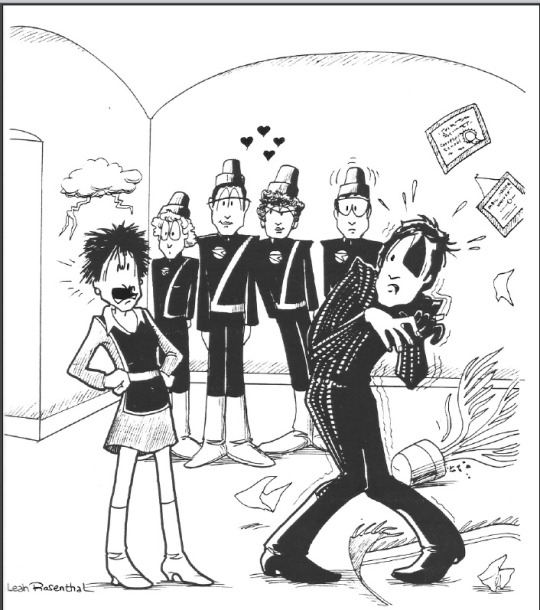
I should add that's us on either end. :)
Of course, we couldn't let that sit unanswered. So the following MediaWest, we marched up to their dealers table dressed in black with spray-painted flower pots on our heads!
Leah was a treasure. We're going to miss her terribly.
Her wife/partner Annie has a Gofundme to help with final expenses:
2 notes
·
View notes
Text

Girljock: The Book (1998) ed. by Roxxie is a compilation of the best articles originally published in the zine Girljock throughout the early 1990s. It was notable for talking about women's sports and the experiences of women who play them before they were popular enough to be regularly broadcast. As Roxxie says in the introduction:
When I originally imagined Girljock magazine as a forum on the lesbian sporting experience, the bits of mainstream media coverage of women in sports either ignored lesbians or would merely report the fact that so-and-so was accused of being a lesbian, or all too rarely, so-and-so came out of the closet. The reality of the lesbian experience differs from what the mainstream of media will report. In Girljock magazine, we are describing our own sporting lives, without the mainstream media's bias. Good-bye to all that mainstream mush. Since there aren't a lot of women's sports writings (yet), many times we have published the pioneer article on a particular aspect of a particular sport. Not all the women we have interviewed, or the contributors, or the Girljock staff are lesbians. But all of them believe in the value of being part of a new lesbian-positive athletic female universe. We are disgusted with the butchphobia and lesbophobia which has held back the women's sports world.
The Browne Popular Culture Library (BPCL), founded in 1969, is the most comprehensive archive of its kind in the United States. Our focus and mission is to acquire and preserve research materials on American Popular Culture (post 1876) for curricular and research use. Visit our website at https://www.bgsu.edu/library/pcl.html.
11 notes
·
View notes